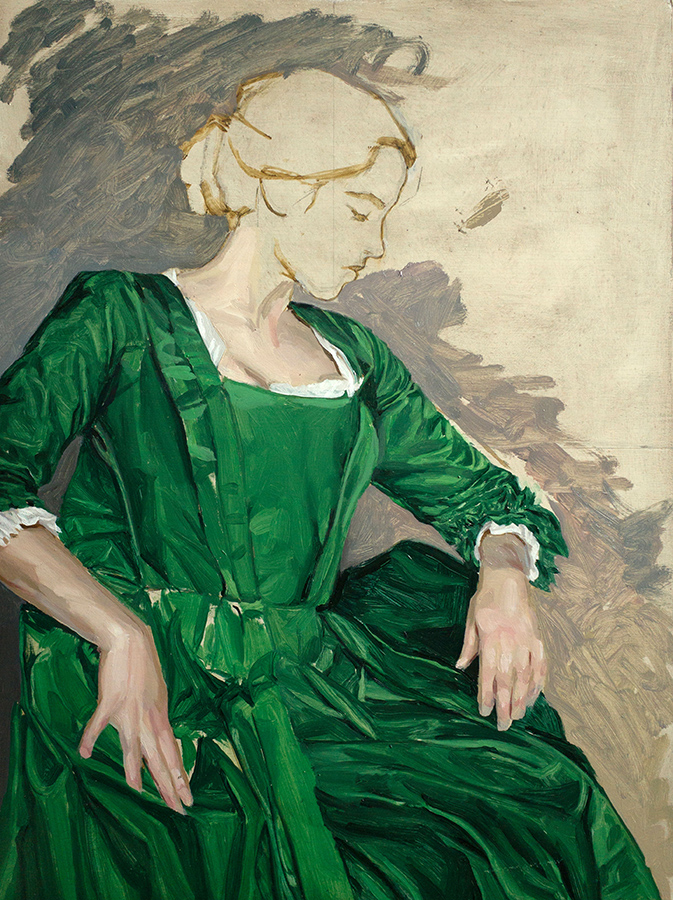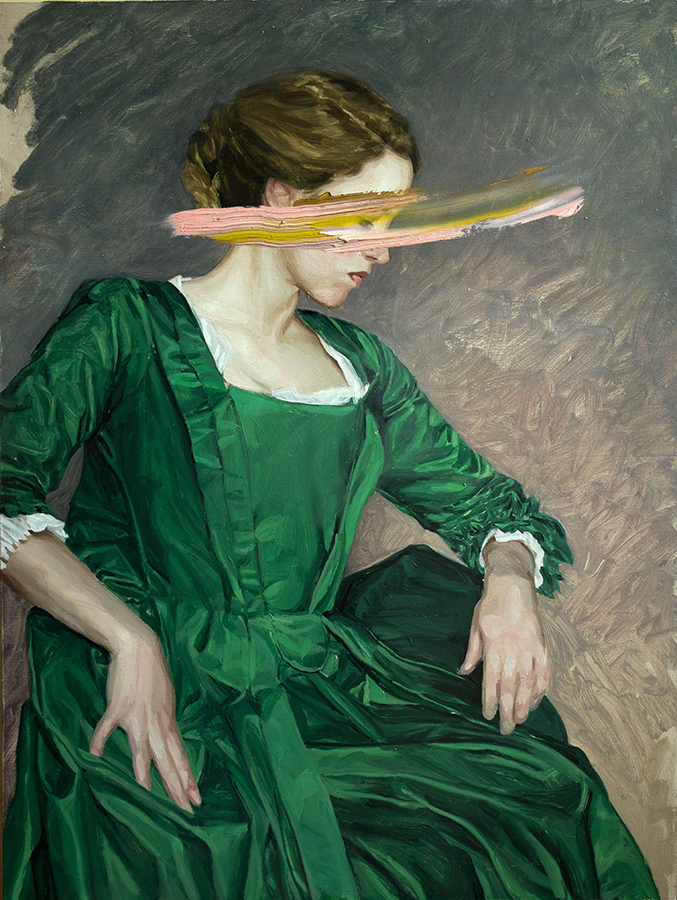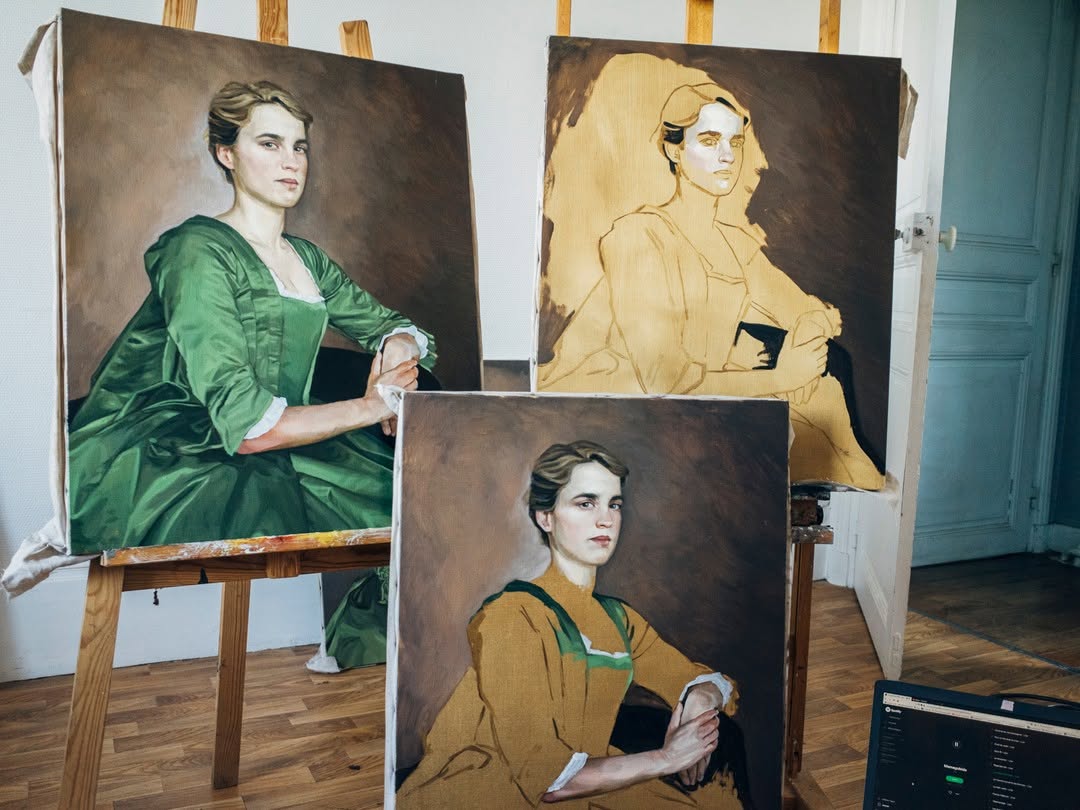
Criterion DVD Menu

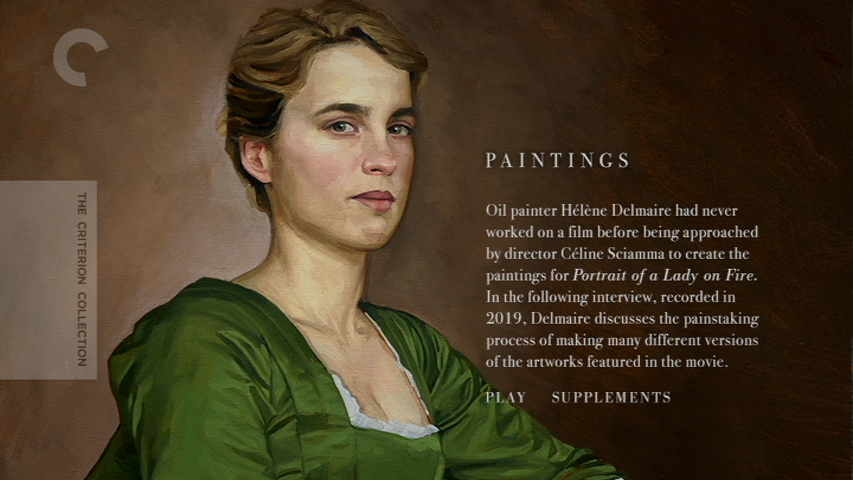
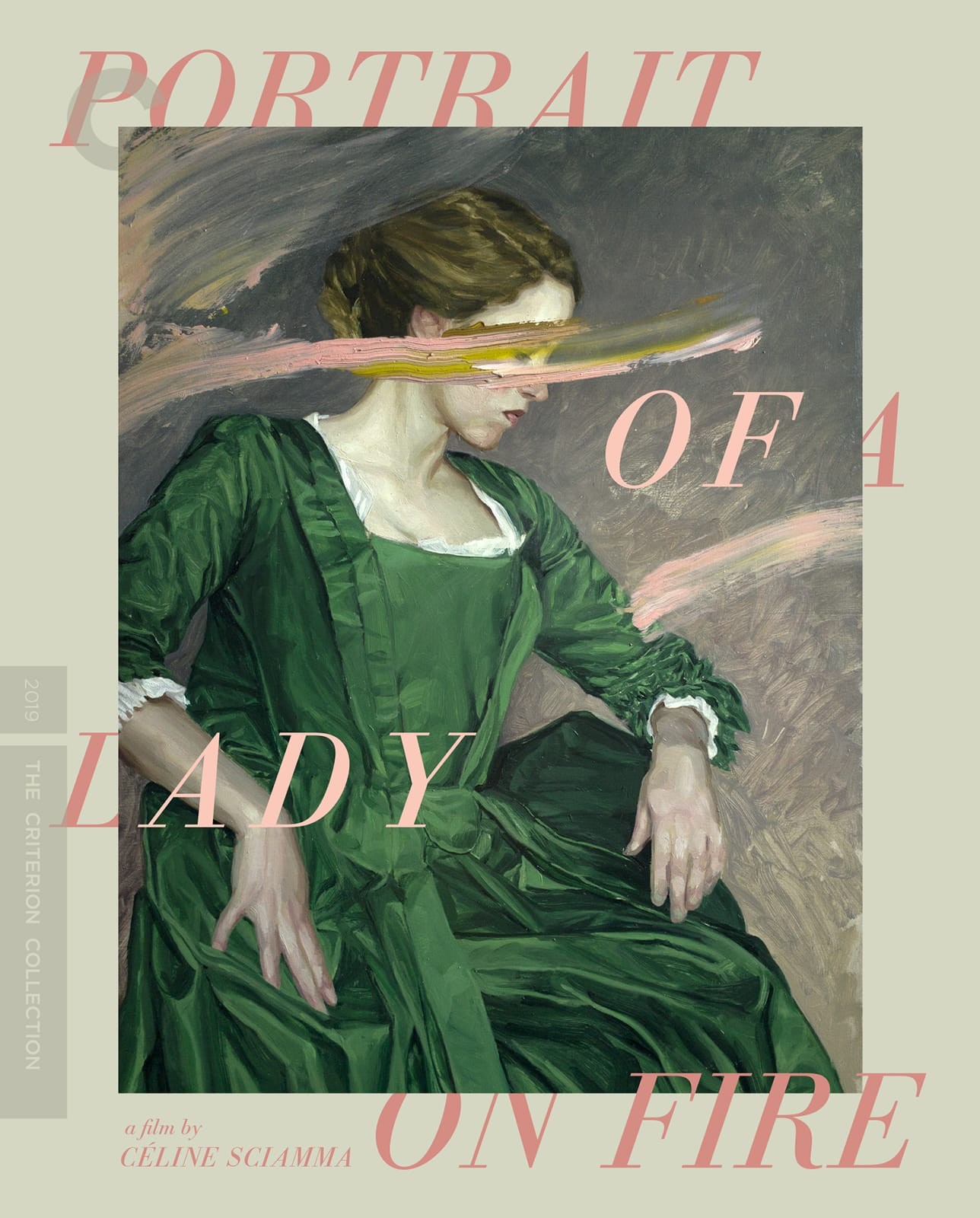
Criterion cover. Notice that only the words "of" appears on top of the painting. Other words are partly hidden by the painting except for "Fire"
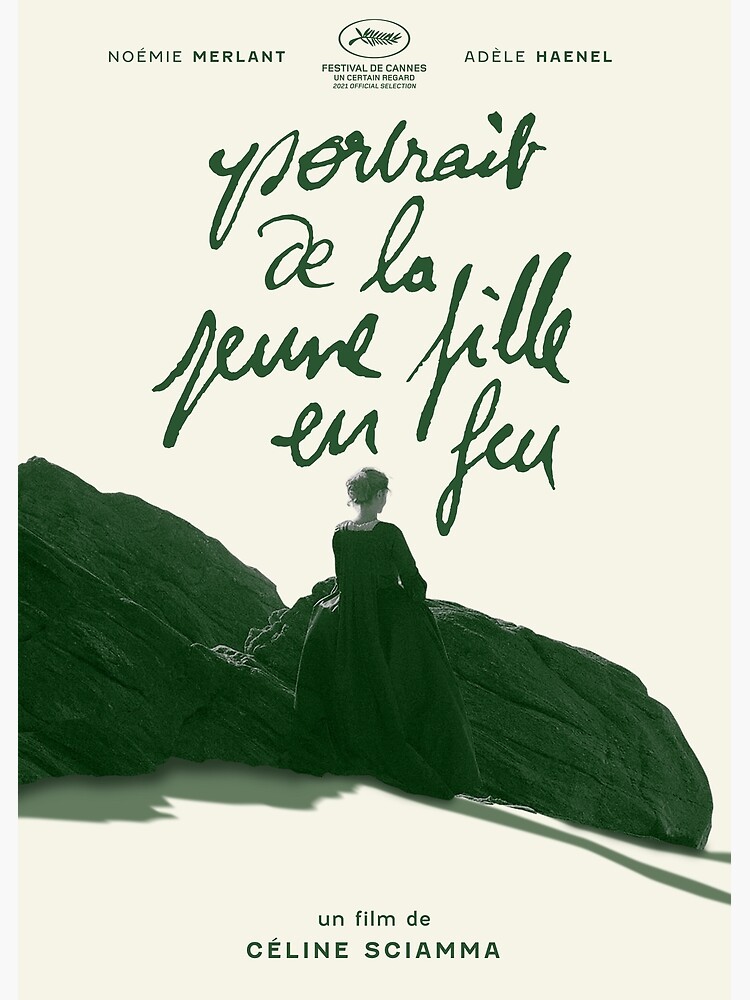

The French title is Portrait de la jeune fille en feu. "La jeune fille" should have been translated as "the young girl, not "lady." https://www.genre-ecran.net/IMG/pdf/jff.pdf
The first portrait.
We see Marianne approach the first painting with the reverse side of the canvas visible. She turns the canvas (unframed) around, cut to her face shocked, cut back to the reveal for us.Hw many ways can you say good-bye in person and through images? How many ways can the lost person be remembered?
The title of the film is also the title of a painting. It is mistitled since it is a landscape painting with a woman in of a very small size (the camera stops rather than focus on any details, the way Marianne's view of the first by candlelit highlights certain parts of the woman's body but not her face.The dress of the woman in the landscape who is looking at the full moon is on fire.

Is the title of the film really about Marianne? She gives the title of the painting while posed like Marianne so students may draw her. And that doubles as the film's title. Are model and painter already doubles? Marianne's painting is not a portrait.
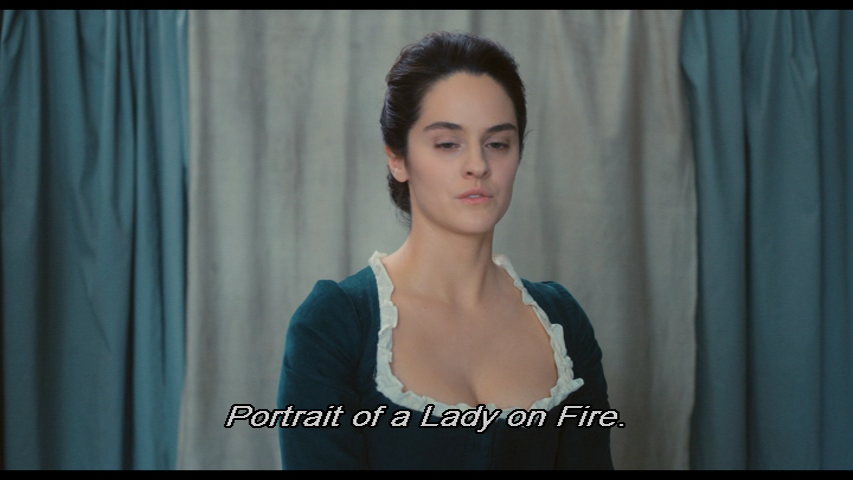
Timestamp 1:58:27
Marianne is wearing the same dress we later see Heloise wearing. The film begins with the painter sitting as the model. Only when the film moves into a flashback do we see the model or perhaps template whom Marianne poses as for herself. The similalrity is established by the parallel shots. What came before chronologically comes in reverse order. The later shot precedes the shot it comes before in the film.
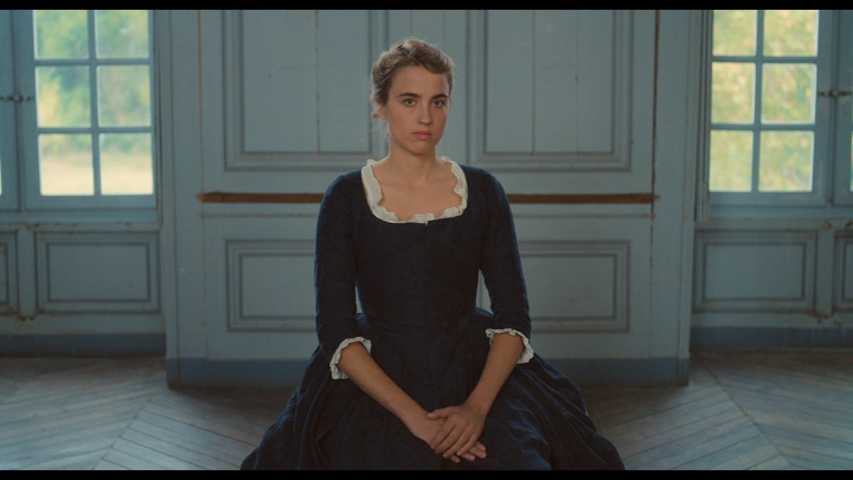
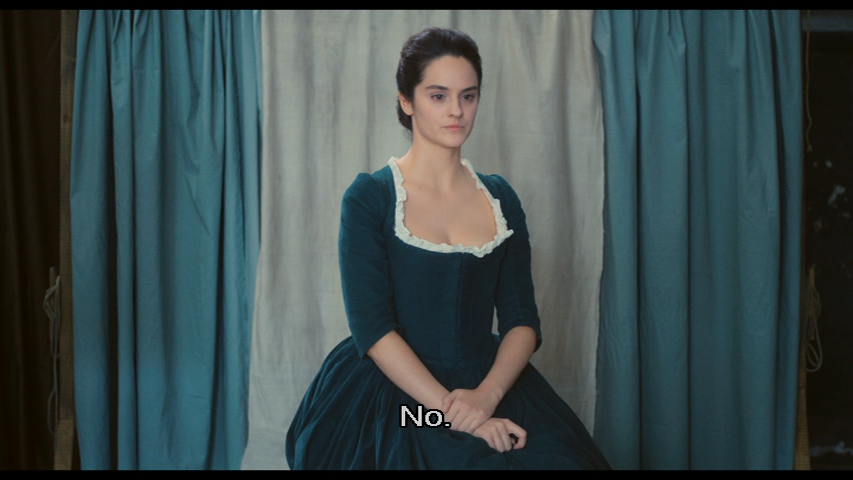
During her first night at the house, Marianne explores different rooms by candlelight. Eventually, she finds bread and cheese. Sophie comes in and Marianne asks her what happened, why the previous painter was unable to finish the painting. Heloisie says "I don't know."
Marianne continues to explore the house with a candle and discovers the previous painting. The film cuts immediately to the bottom f the dress Marianne wore in hte first painting.
1 48 55

She turns her head and the focus racks from Marianne to the canvas.
reverse shot at 1 48 06 The back of Marianne's head now appears in the mirror in soft focus, and she is in focus as she appears to be walking toward the canvas
Reverse shot at 1 47 59.
Light source is moonlight from a window. The light shows the canvas, initially by itself in the frame. Marianne slowly walks toward it after entering the frame.







As Marianne gets closer to the canvas, the focus racks: the canvas goes out of focus and she comes into focus.
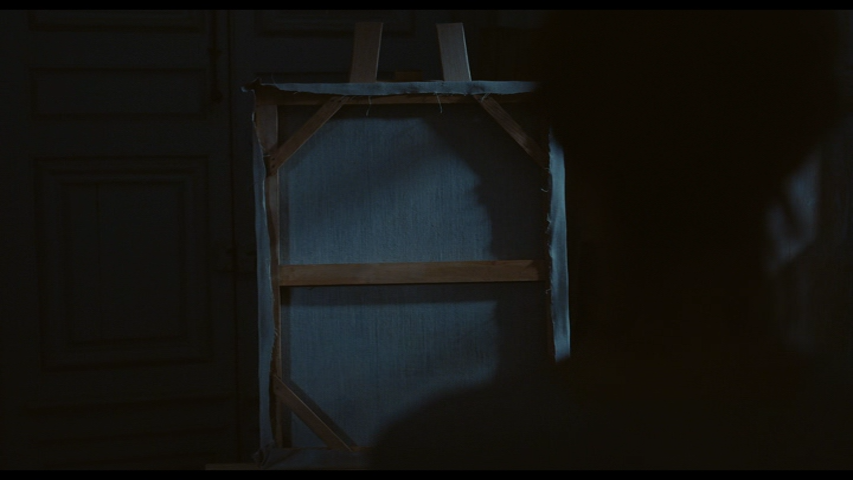


Marianne's head blocks our view of the painting's reverse side. Later, Héloïse's mother's head will block our view of the portrait she defaced. And even later, Marianne's head will block our view of the portrait of Héloïse and her daughter. We don't see the the defaced portrait after Marianne defaces. The film cuts away before we can. However, we later see it in soft focus behind the mother and then behind Heloise. We see Marianne look at the first portrait in shock before we see the portrait.

Marianne begins to turn to the painting over so she can see what's on it.
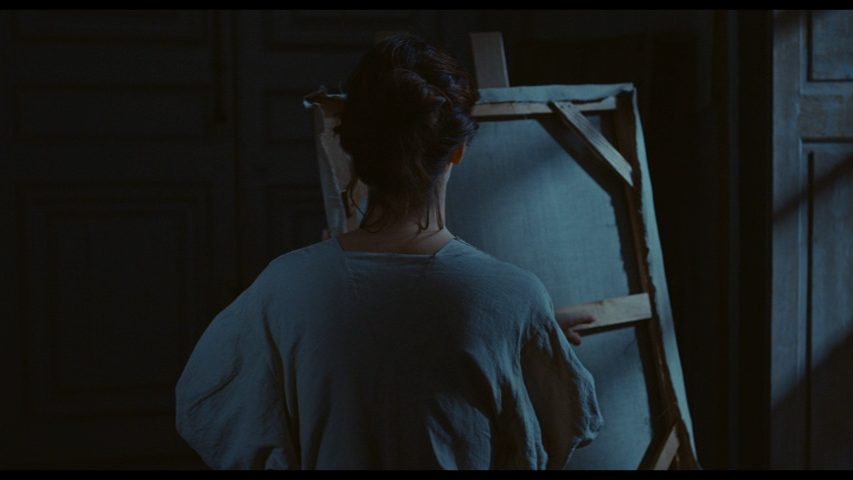
We then get the reveal. Has the face been painted over? Or is it a undercoat for the portrait to be painted?





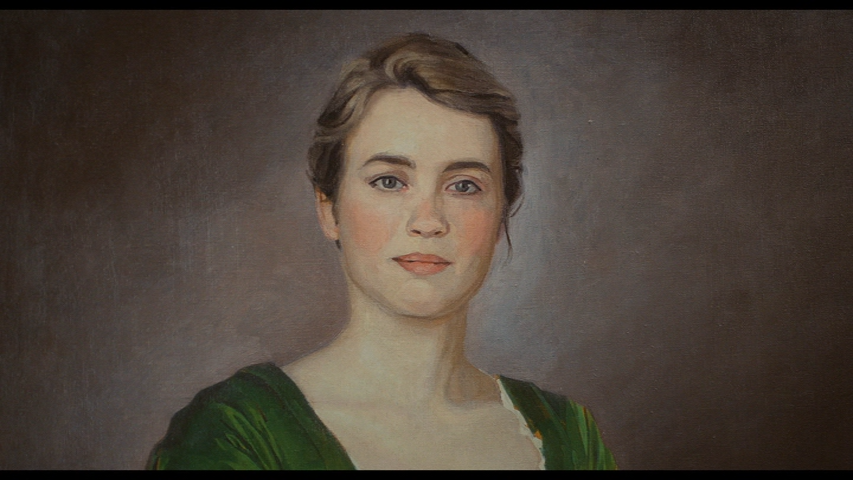
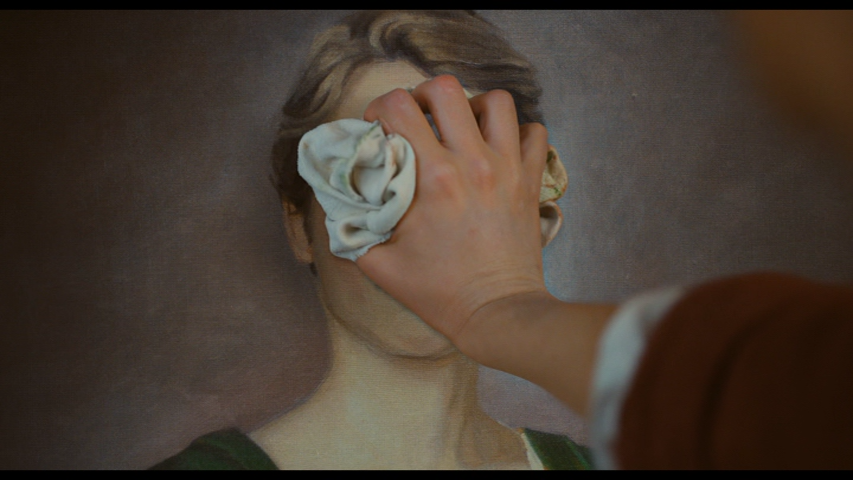
The mother's head is in our way just the way Marianne's head was in front of the first portrait before we see it.
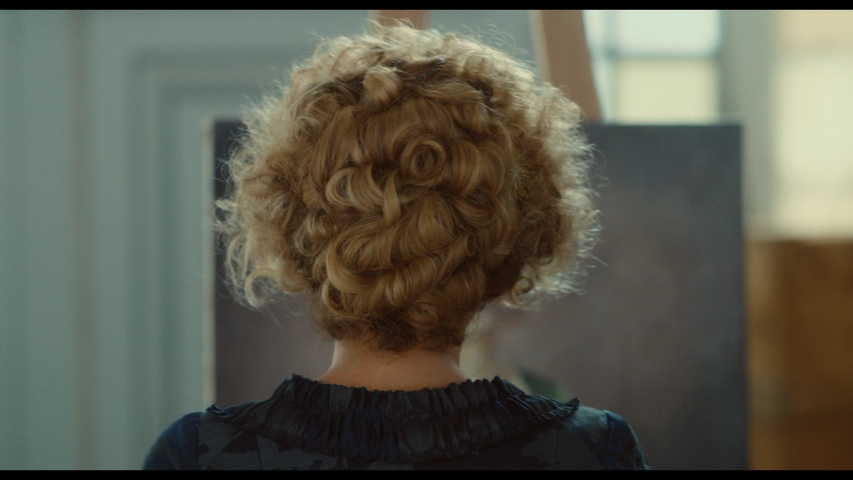
Mother, painter, and dead sister. The mother discusses the painting someone was hired to make of her.

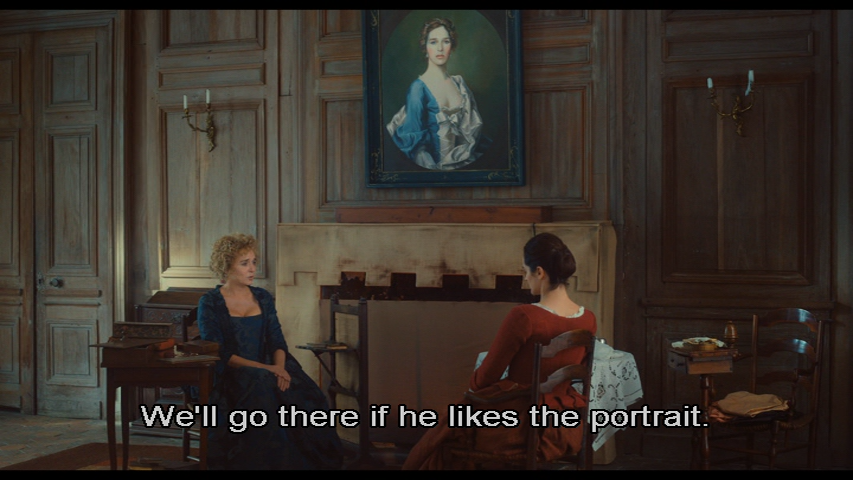
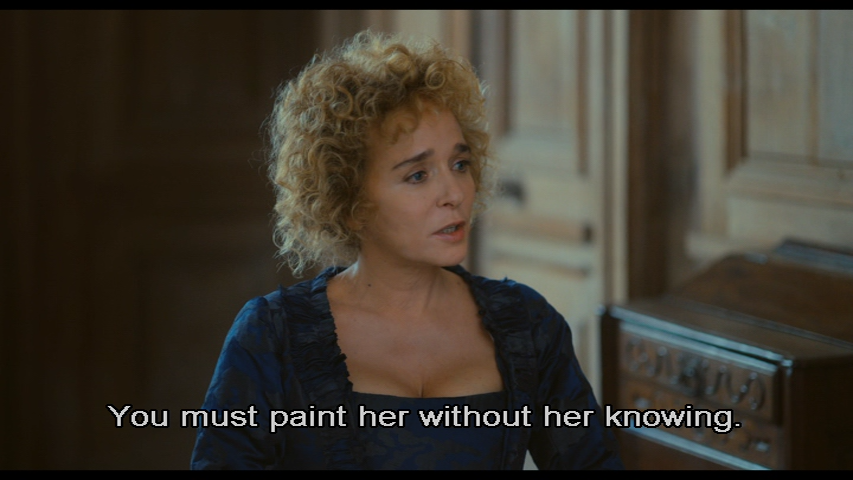
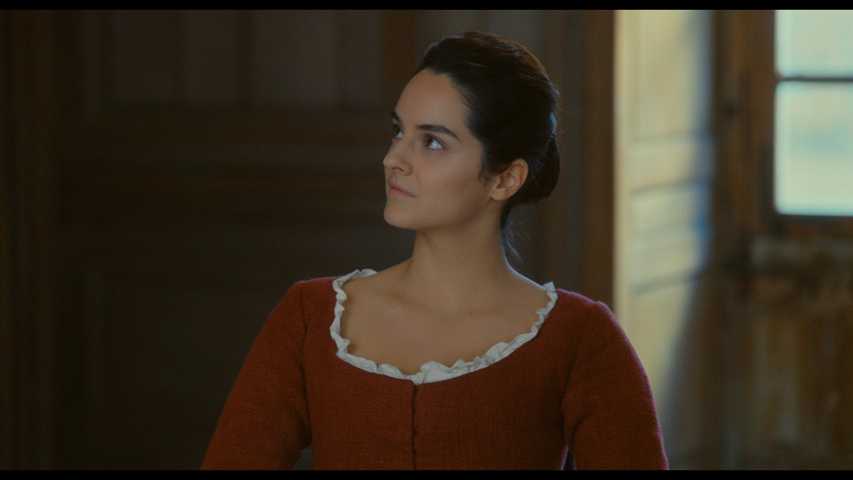
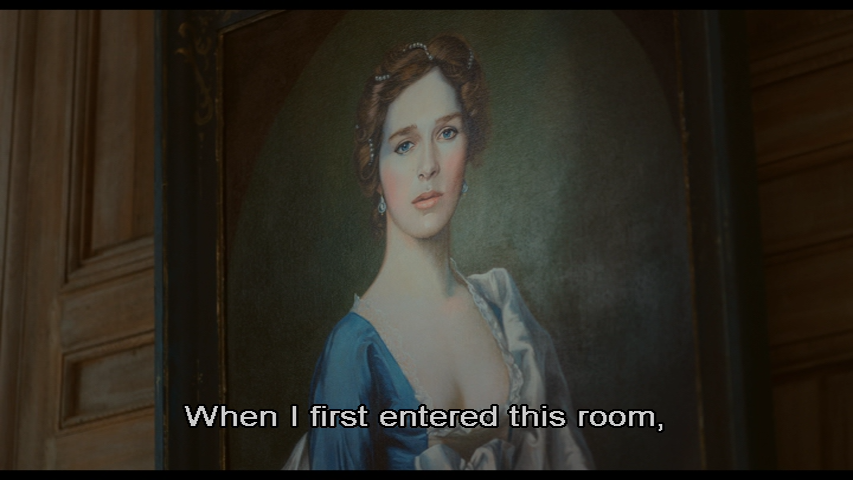
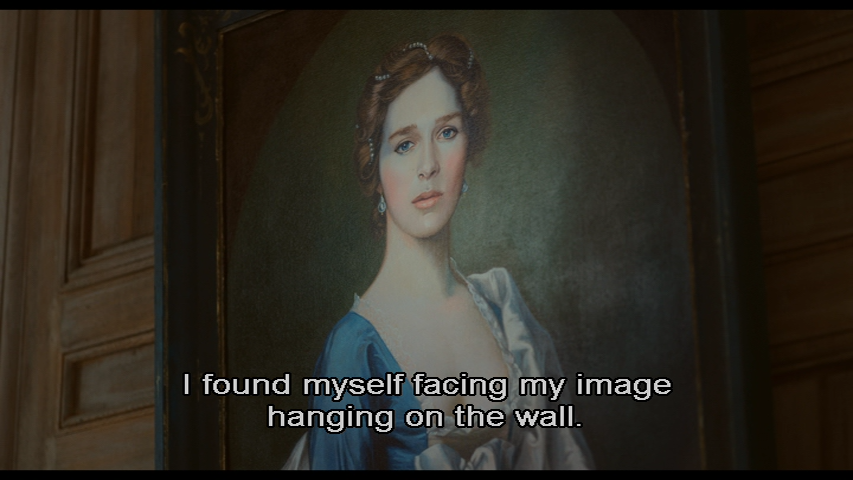
Marianne's first sketch of Héloïse on canvas.
Marianne finishes her first portrait, painted with Marianne's knowledge.




1 48 45
After she has finished the portrait, Marianne returns to examine the previous painting by candlelight and either burns it intentionally or unintentionally catch fire. T
Why does Marianne bother? Why does she want to see the portrait again? Why does she need to see it destroyed? By fire? Is the a portrait on fire? Is there more than one? Marianne looks at various parts of the portrait as if each were spotlit with candlelight. It's not clear why puts the candle so close. Is she setting the fire accidentally on purpose (waiting for the wind to blow the flame onto the canvas)? to the first portrait of Marianne. We don't see the defaced head until the painting begins to burn. hen she watches it burn in the fireplace where she has somehow taken the painting. Marianne just lets the portait burn. This portrait is on fire.
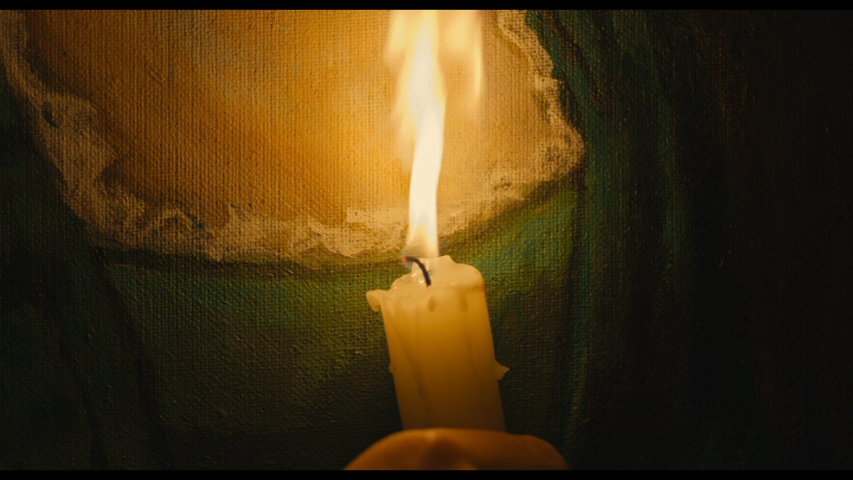

Cut from the painting on fire to what's left if it burning in a fireplace by Mariane and looks on, her head turned away from the camera.

The relation between portrait and the painter of its replacement is displaced later onto Marianne and Héloïse. Héloïse's dress is catches fire, probably from the wind too. She's further away from the camera than Marianne. When Marianne sees that Heloise's dress is on fire, Marianne lets it burn and stares instead. Héloïse is staring at her in a shot reverse shot sequence. Marianne rushes to Héloïse only after two girls have put out the fire with blankets. Héloïse falls down before Marianne reaches her. There is an elegant match cut between a close of their hands grabbing their forearms after the fire out and then when they are walking on the beach (see below).
What, then, is the connection between Marianne's painting of Heloise on fire and letting the painting burn?

The immediate source for the painting is the scene when Heloise's dress catches on fire and Marianne does nothing. In the film, Heloise does realize her dress is on fire and fire is the only source of light. In Marianne's painting, the full moon is the light source and the back of the lady's dress is on fire, not the front. Is the woman in the painting aware her dress is on fire? Is fire alreay metaphorical, as in love song lyrics like "Baby, I'm on fire?" Or is this an example of the subject of turning that comes up in the film in relation to Orpheus? The literal turns into metaphorical and vice versa.
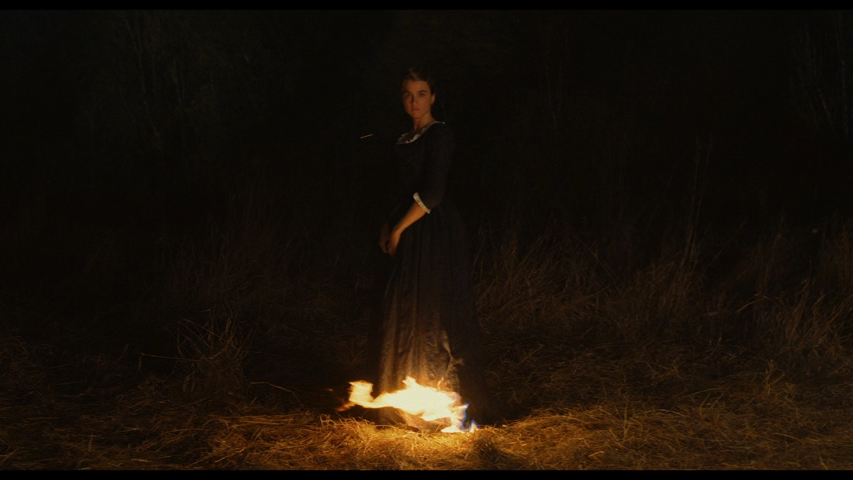
Shots of Marianne

Is Marianne looking at Héloïse as if Héloïse were a model for a painting? Is this when she gets her idea for the painting she entitles "Portrait of a Lady on Fire?
The woman who paints is also the woman who is passive in the face if danger.
Is the model also a phantom and a woman who does not move when she is danger of immolation?
Do the characters have one personality or mutilple personalities?
First Ghost of Marianne, racking focus from Marianne to Héloïse. Perhaps the ghosts are meant to suggest that Héloïse is already lost, a silent image, like a painting we look at and then don't.
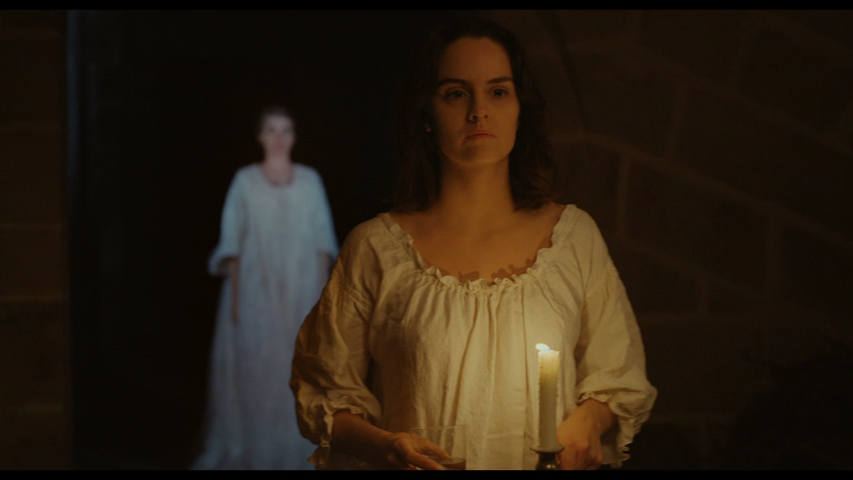
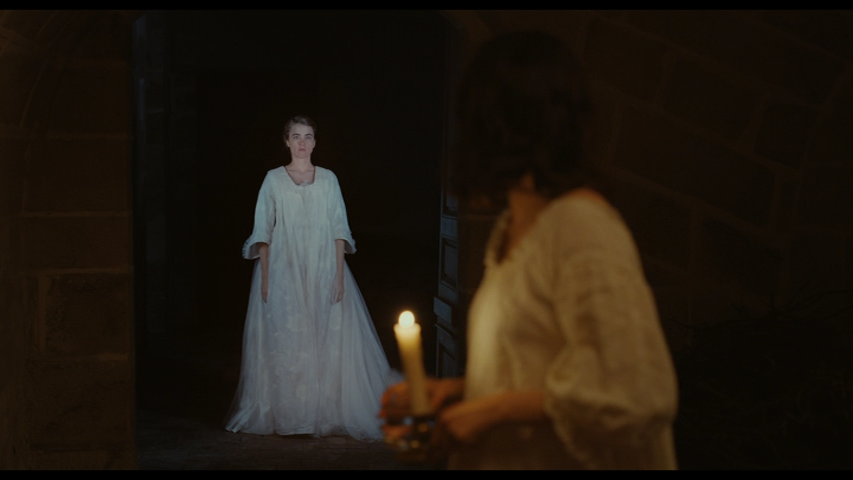
Second "Ghost." Marianne sense it behind her (it's a circulr shape at this point) turns to see it and then back to ocninue walking down the starway and into a room where she meets . . . the living Heloise.
Compare the circle of light (it turns out to be a lit candle) and the full moon in Marianne's painting.
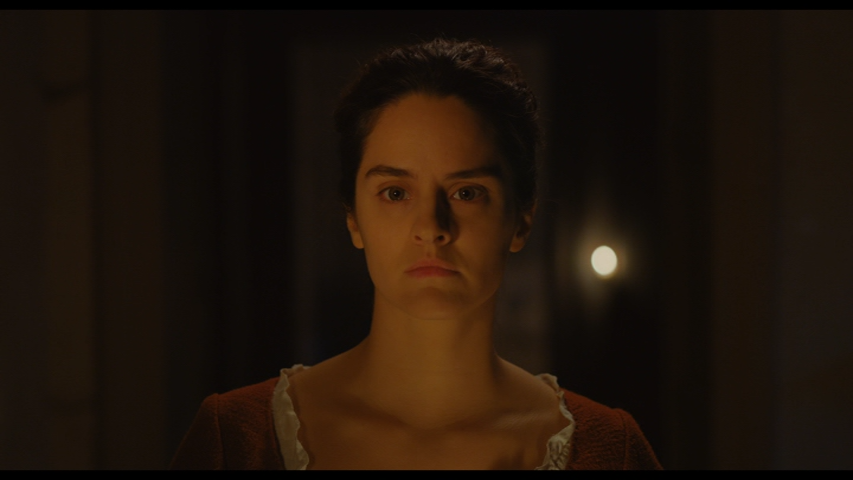
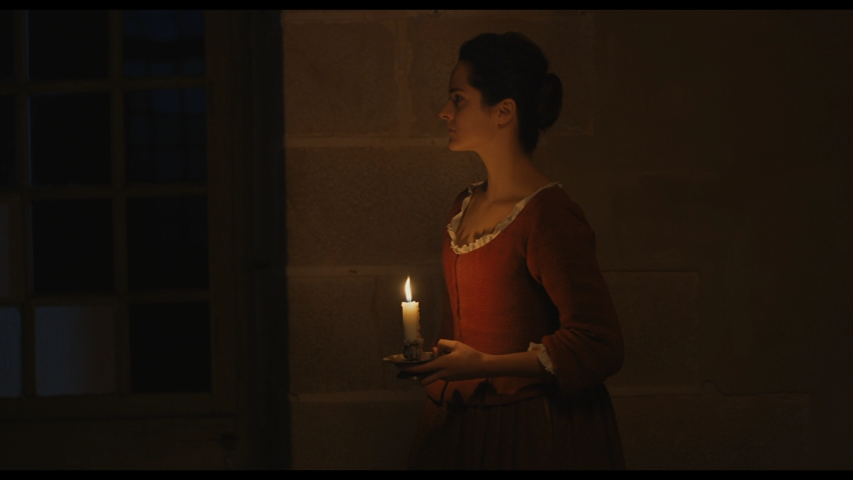
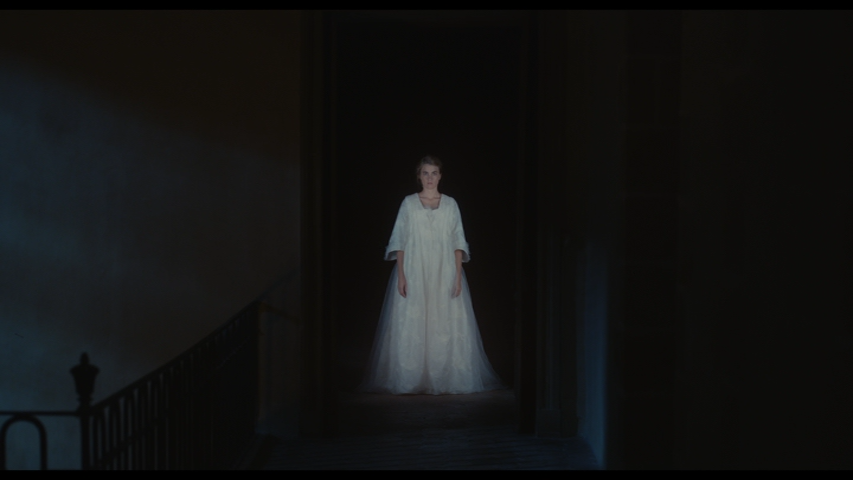
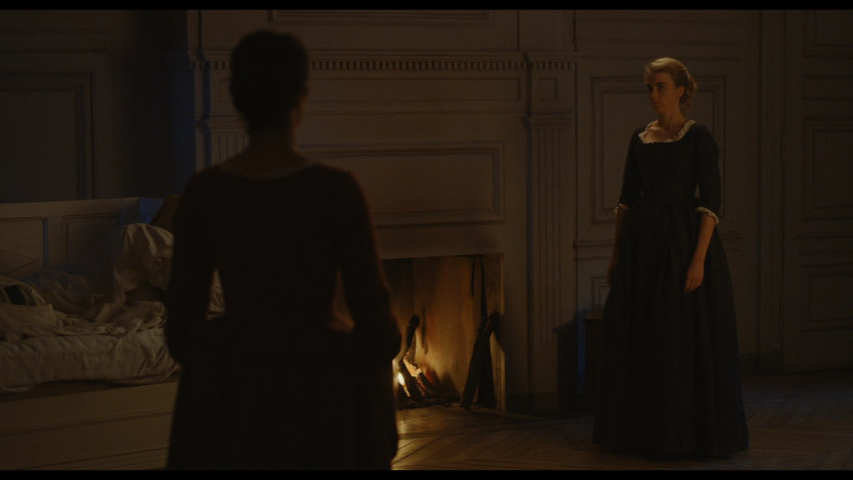
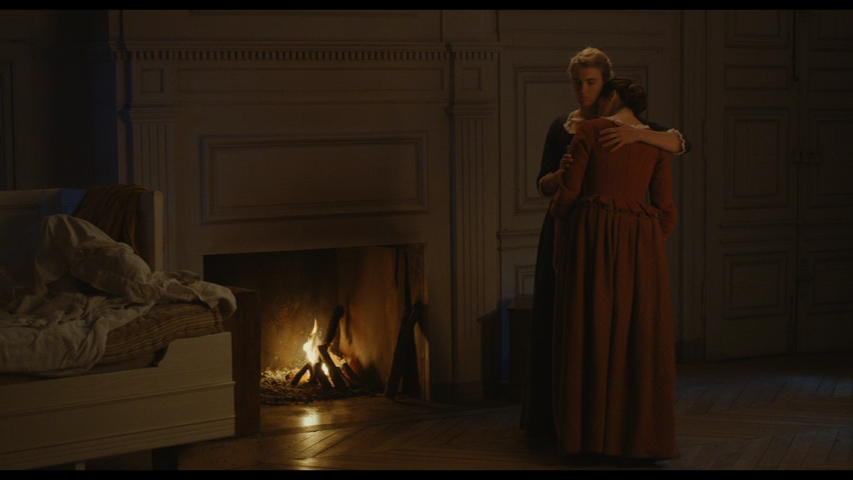
Héloïse is about to become the Third "Ghost" when her mother checks out her bridal dress while Héloïse stares at Marianne, who is staring at her.

Third "Ghost" calls outs to Marianne to turn around and appears in daytime. Again, there is an echo of Orpheus.
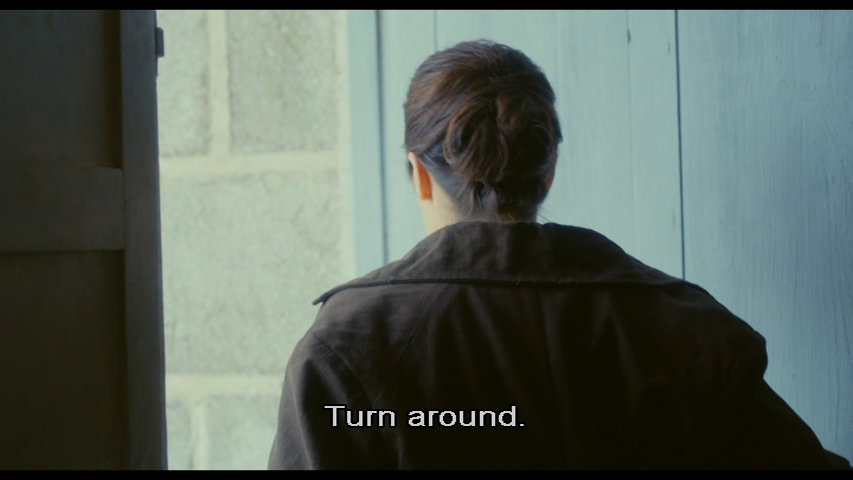
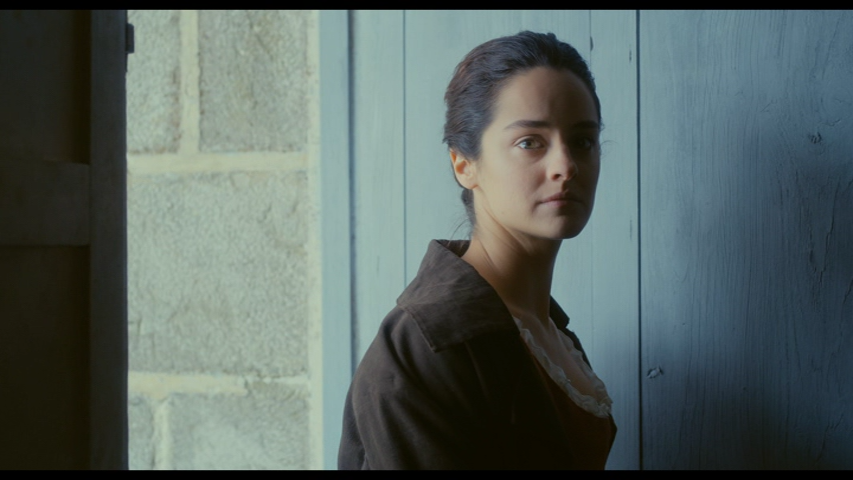
Now Héloïse is the third ghost, only she now looks like the actress dressed up in a white dress. Is she Heloise? It seems impossible that she could have gotten there so fast. She even has a shadow. She too fades away into darkness, but that maye because Marianne closes the door behind her.
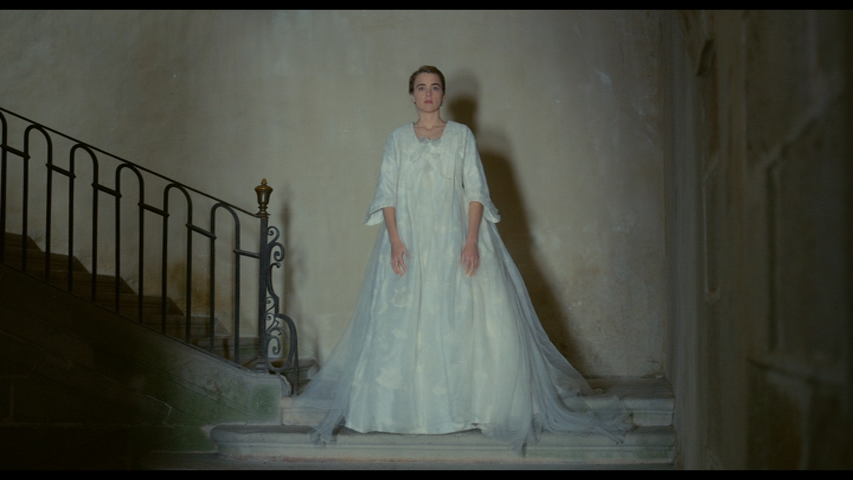
Finishing Marianne's second portrait of Heloise.
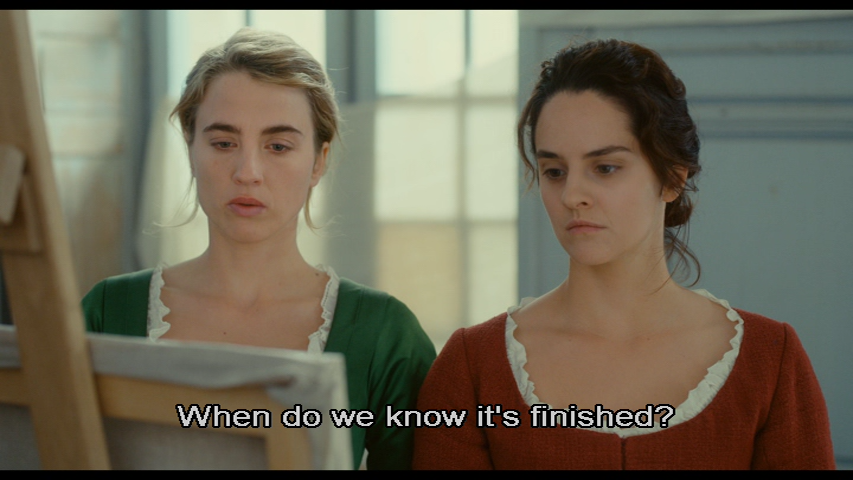
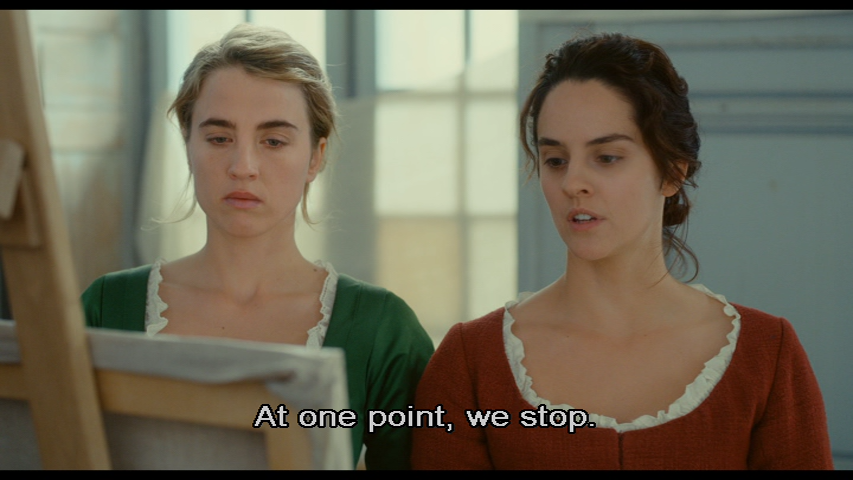

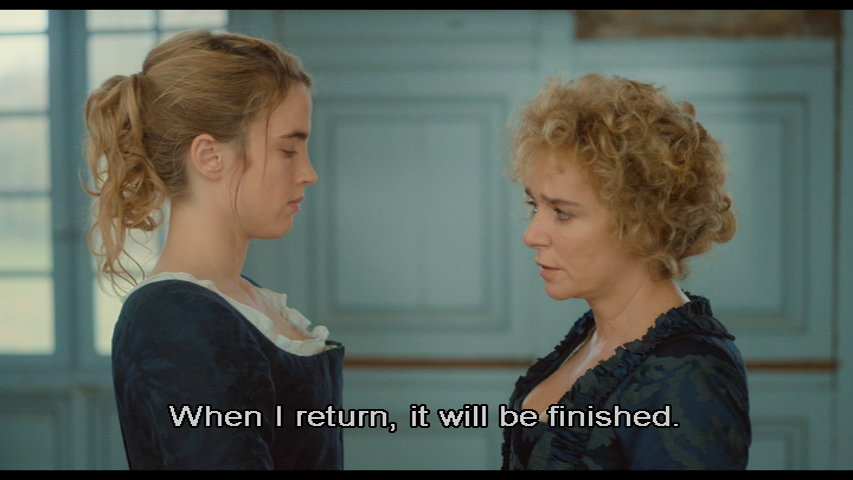
Marianne as already posing as if for her portrait.
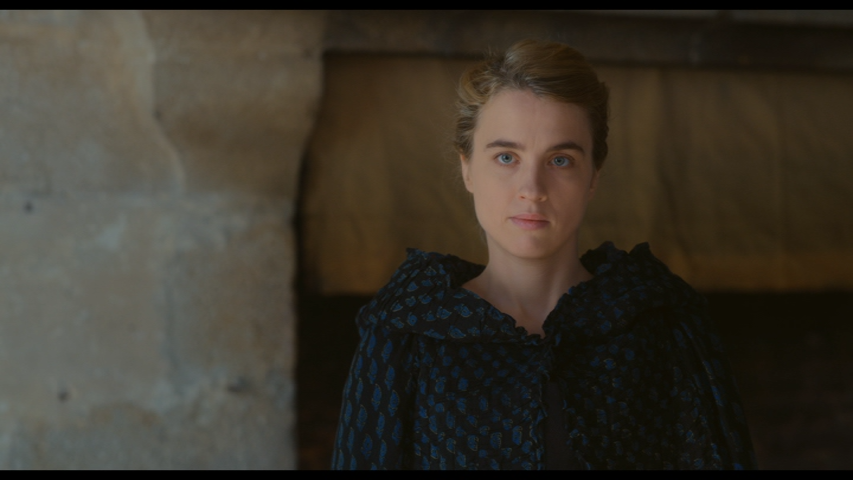
The first portrait by Marianne.

Heloise looks down and sees her dress is on fire. But she stands there and does nothing except look at Marianne.
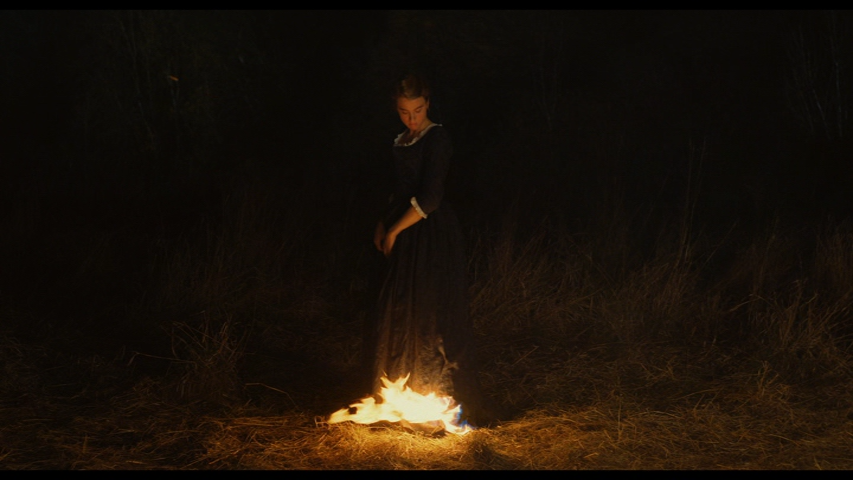




The girl student artist at the end of the film is the same girl who took the painting of Portrait out of stock at the beginning of the film. It's another example of intimacy developing out of the painter watching the model. The best student is the one who gets to know Marianne. Marianne is wearing the same dress. So is the student. Perhaps they each only have one. Perhaps were budgetary reasons.
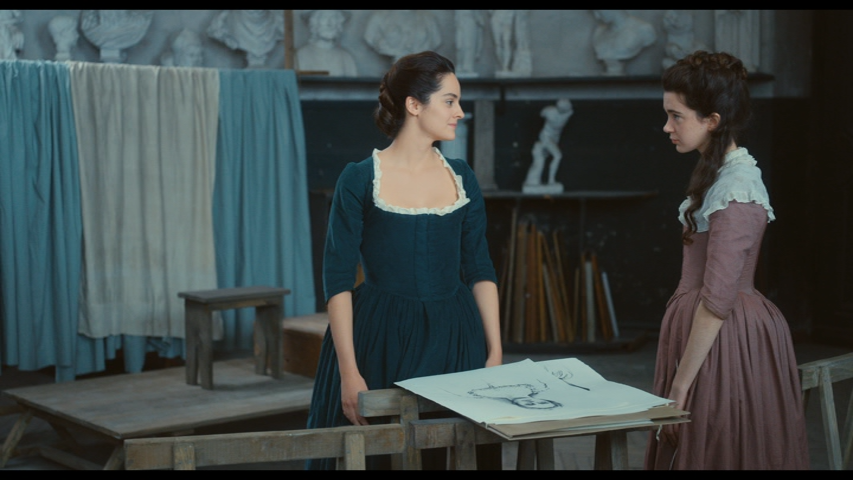

The best student gets one of three close ups of three students.
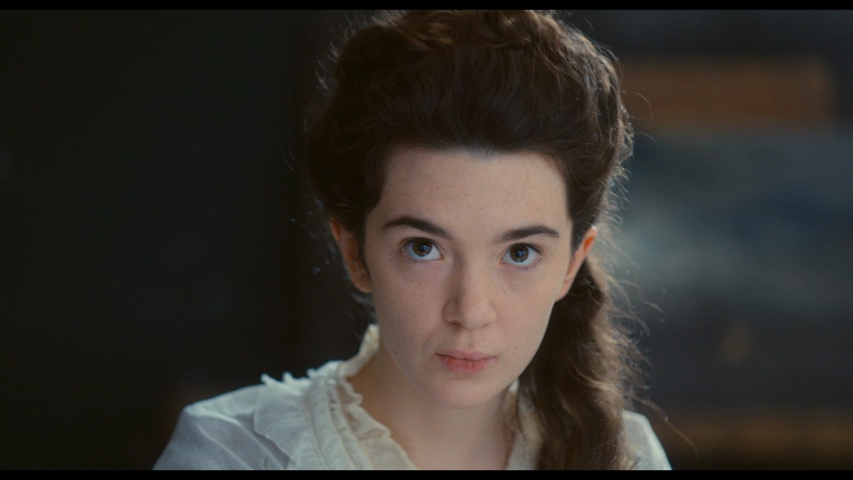


Pulling the croset strings tight. Marianne (Noémie Merlant) and Héloïse (Adèle Haenel). A metaphor for the film's failings? Everything is tied up and tied up too tightly.
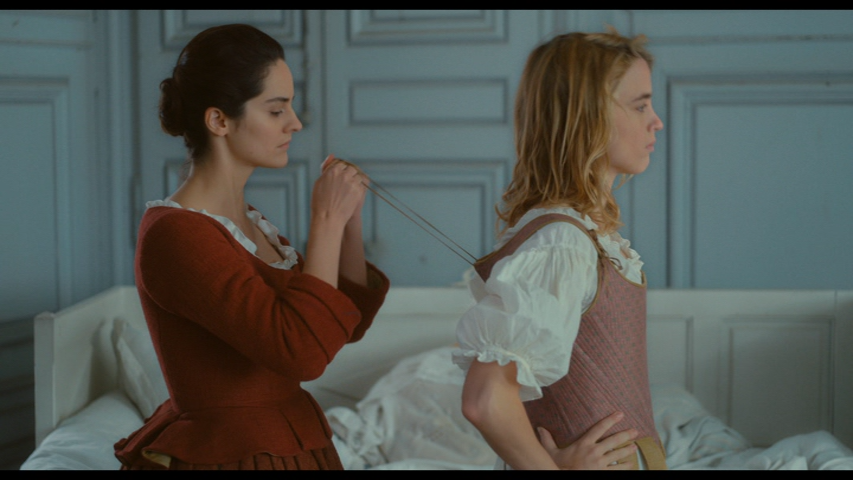
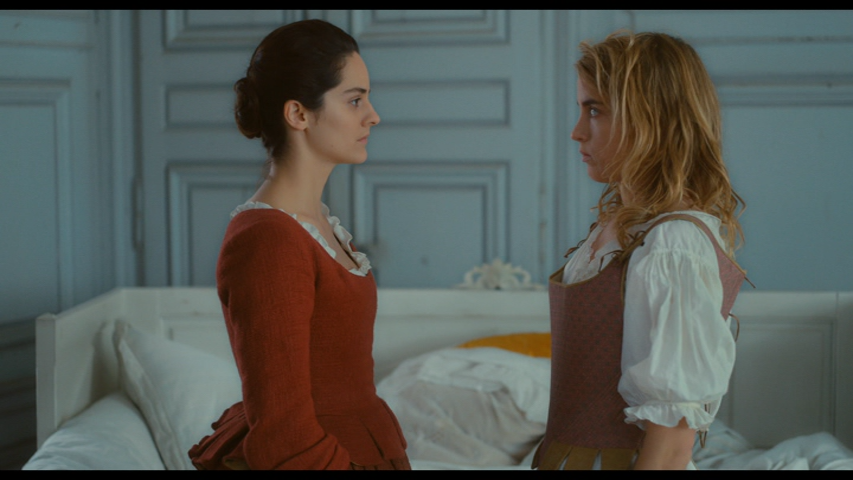
Marianne's self-portrait on page 28 of an edition of Ovid's Metamorphoses, translated into French. The image will enable Héloïse to remember Marianne, and Marianne remmebers when she later sees the portrait of Héloïse and her young daughter.

Is the sketch a composite of Marianne's face (in the mirror) and Héloïse's body? Kind of a prudish shot of Marianne (in focus) looking at Marianne's genetalia (in soft focus)? Or a different kind of union. The face is an obscene place tht has been sufficently beautified to render it to make the nuded body acceptable?

Is the model a muse? Here there are two models, two heads. Almost exactly the same shot, only is now the camera is further away Marianne is soft focus and we can see Héloïse's head and upper body Heloise is deep focus. This kind of formal symmetry betrays a conservative French neoclassical aesthetic.

Marianne's hands as painted in the first portrait.
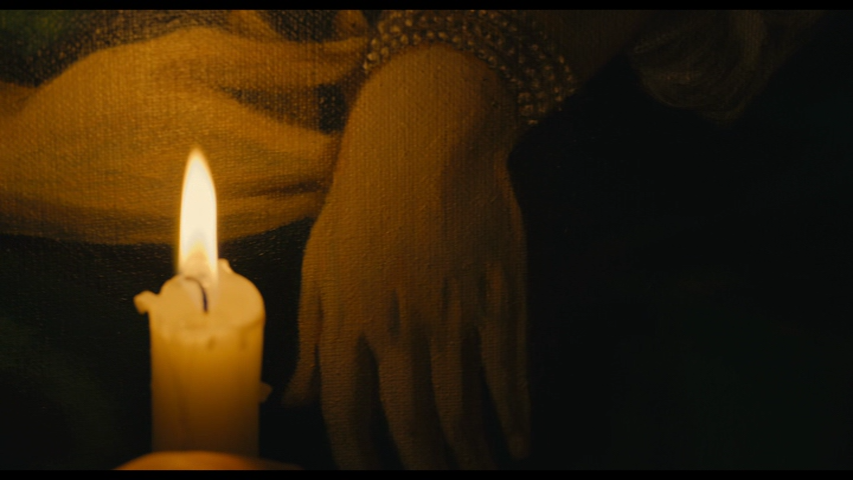
Drawing continues after Marianne finishes her second portrait.
Marianne draws a miniature of Héloïse as her own keepsake.

A self-portrait of Marianne.
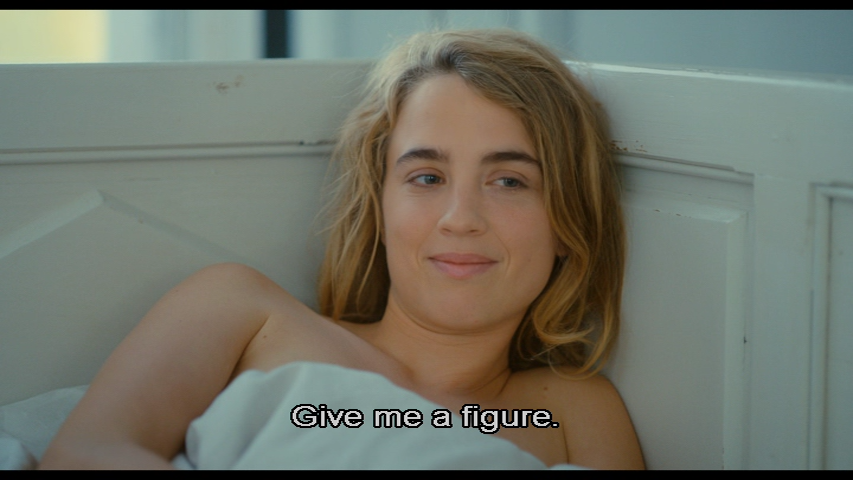
The left page is out of focus so you'll be sure to focus only on page 28. Ovid emerges for the first time. If you know Ovid well, you'll know this is the story of Orpheus and Eurydice.
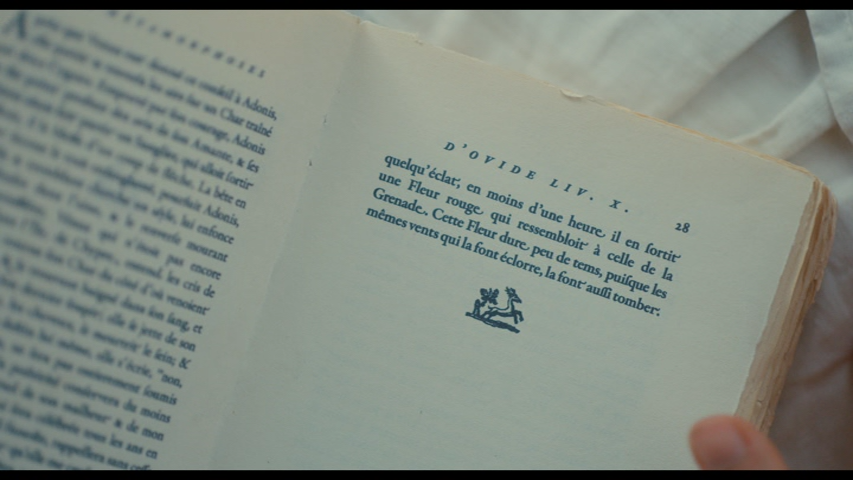
Marianne adjusts the angle of the page so it looks like a paper to be used like a canvas.
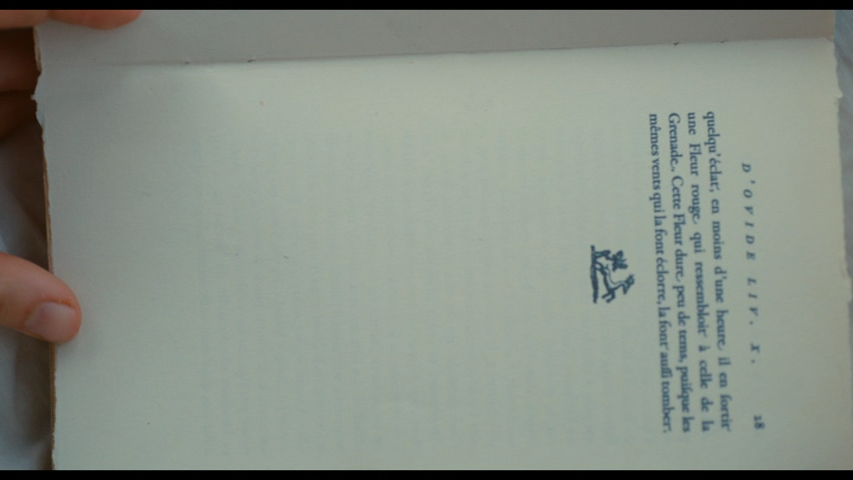
The French is "Quel'éclat; en moins d'une heure, il en fortit une Fleur rouge, qui ressembloit à celle de la Grenade. Cette Fleur dure, peu de tems, puisque les mêmes vents qui la font éclorre, la font aussi tombe:"
Marianne uses Marianne's body for her self-portrait. (see above) Heloise lies with her head on the right. Marianne does the reverse.

Perhaps Ovid has to be illustrated. In this case, Marianne's image (nude?) will serve as a memory for for Héloïse. Both women's portraits are like Orpheus and Eurydice through Marianne's art. (Marianne is like Orpheus, the singer and musician, and poet.) Is this idealization of the myth another losing proposition?
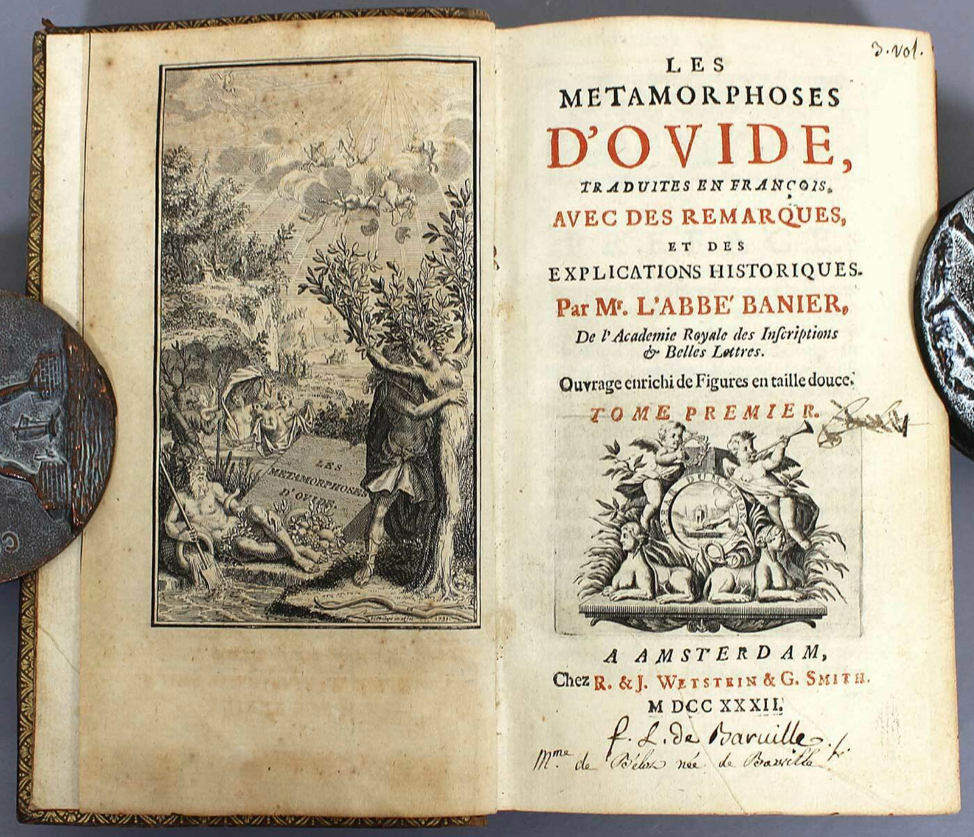
“Not the Lover’s Choice, but the Poet’s”: Classical Receptions in Portrait of a Lady on Fire
Orpheus and Eurydice emerge explicitly.
An older man speaks to Marriane about a painting of Orpheus and Eurydice he finds interesting. She tells him she attributed to her father so it can be exhibited.
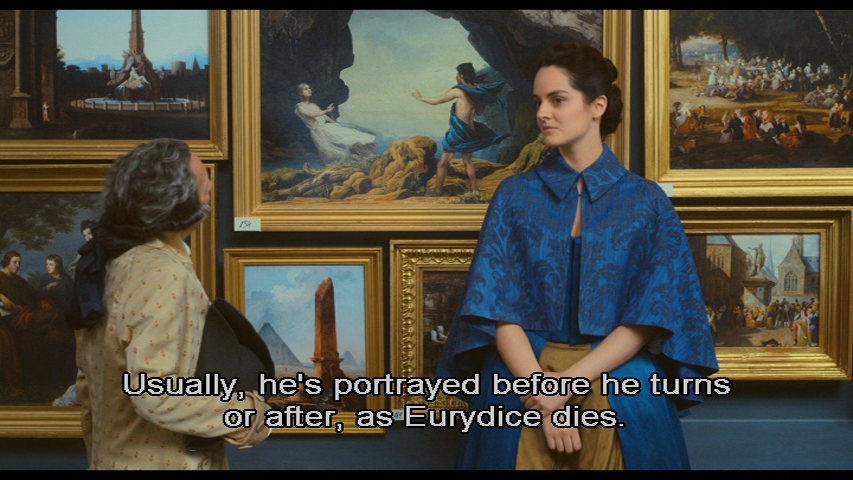
Before or after versus at the same time. The man uses the word "salut" for goodbye. It can mean both "Hello" and "goodbye."
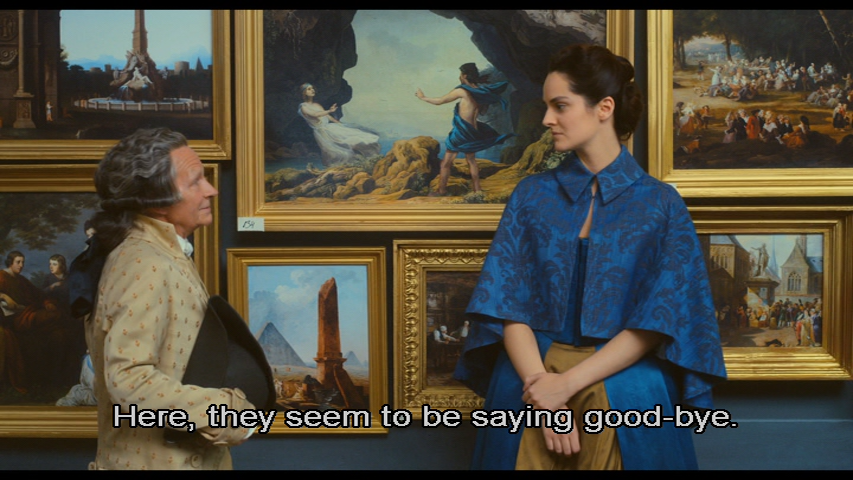
This sentimentalization of the horrific, sad love story is remarkable. Marianne's blue jacket aligns her with Orpheus. Heloise's white dress aligns her with Eurydice.
Portrait of Héloïse and her daughter in an exhibition of paintings: Camera dollies in and tilts down until we see she has placed her finger on page 28! She must be reading be the copy of Ovid Marianne used to draw Héloïse.
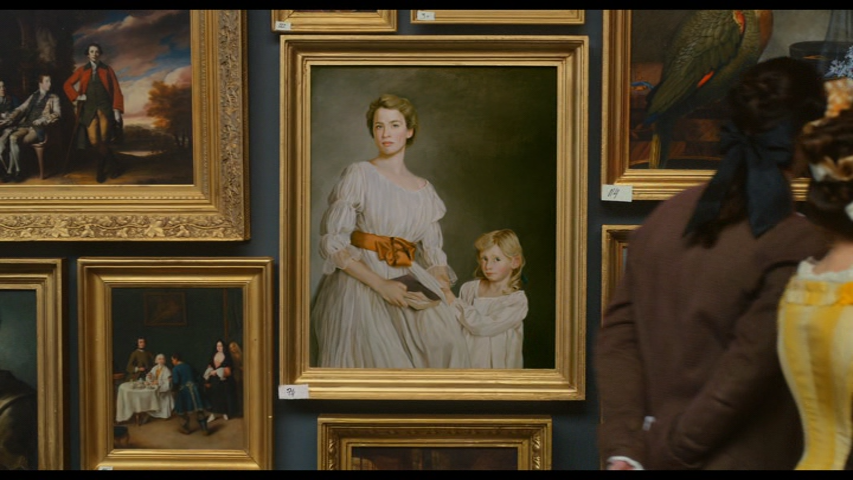
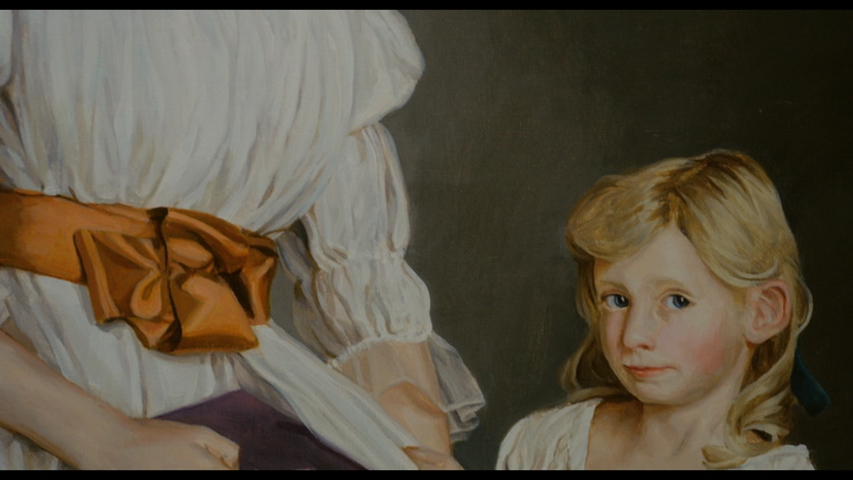
There is no trace of Marianne's drawing of Héloïse in the portrait. Why is the child ignored?
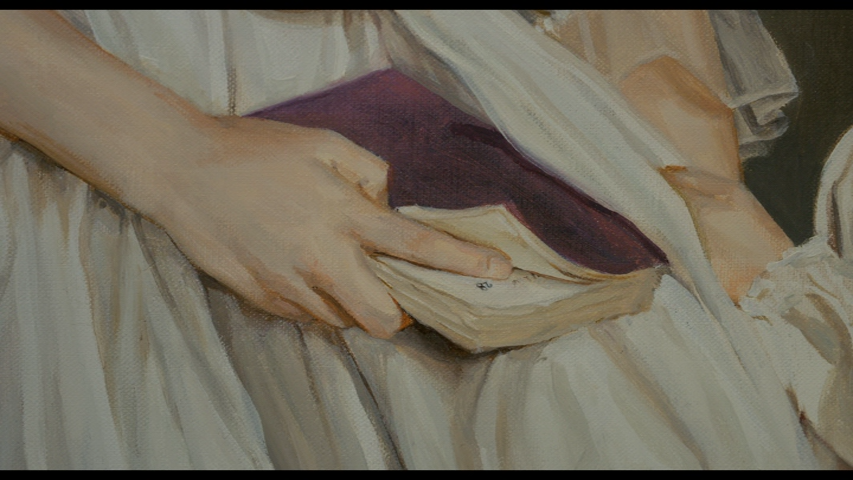
Match cut between Marianne helping Héloïse up from the ground after the dress onher fire has just been put by two girls. What does it mean for Marianne to look at Héloïse when her dress is fire and do nothing but stare? (Does Héloïse mean to commit suicide like her sister, as Héloïse seemed to be about to do when she stopped running at the edge of a cliff? That is the first scene of loss and recovery or at least reassurance in the film. Héloïse has fallen behind and catches up with Marianne only Marianne could have thrown herself off the cliff.)
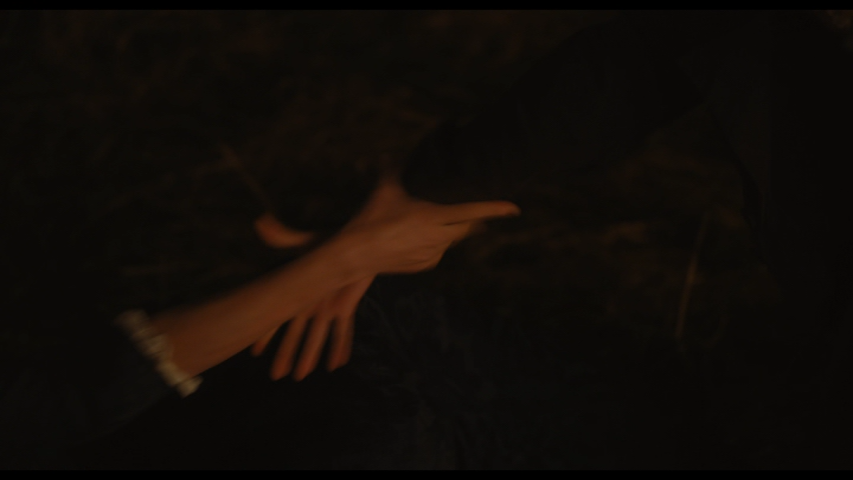
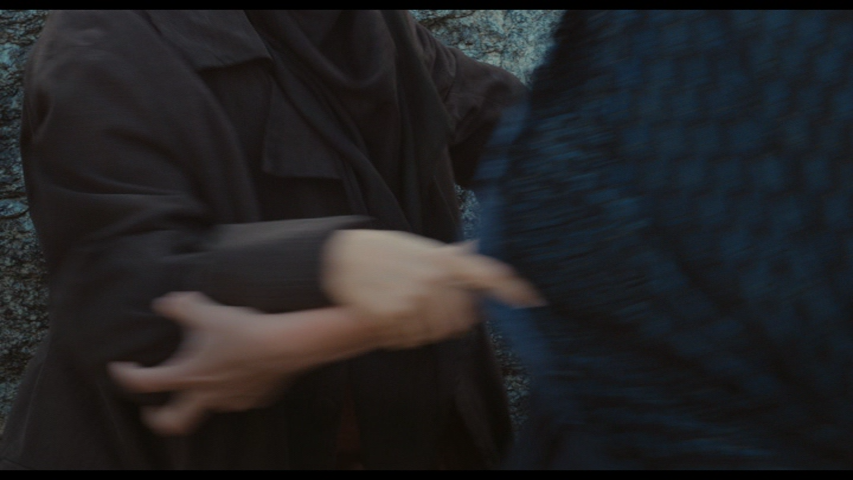
Another headless body of Marianne used for the portrait second portrait? Or is it a self-portrait given that Marianne is hte posing. She also thinks she should not be wearing Héloïse's dress?
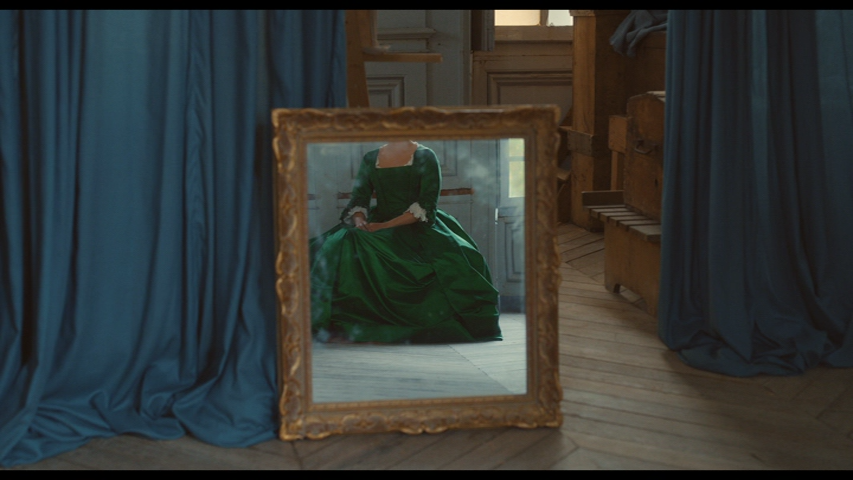
Marianne posing for the first portrait.
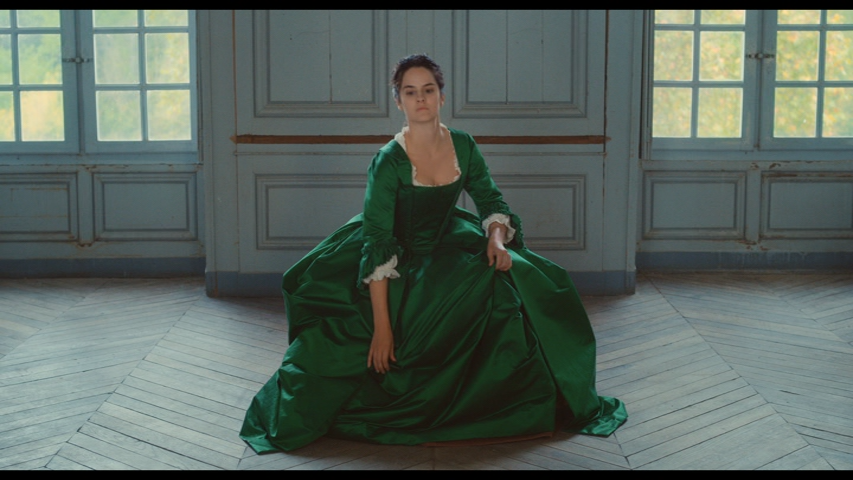
Marianne's second portrait. Héloïse does not like it and then Marianne defaces it , thereby repeating the same gesture in the first painting.


The mother's head is in our way just the way Marianne's head was in front of the first portrait before we see it.

Another two shot in profile, this one juxtaposing the model and her defaced portrait. As is the case with the vast majority of shots in the film, this one is in soft focus.

Marianne opens her canvas crate. A man nails it shut near the end of the film, same shot just after we see it placed in the crate.
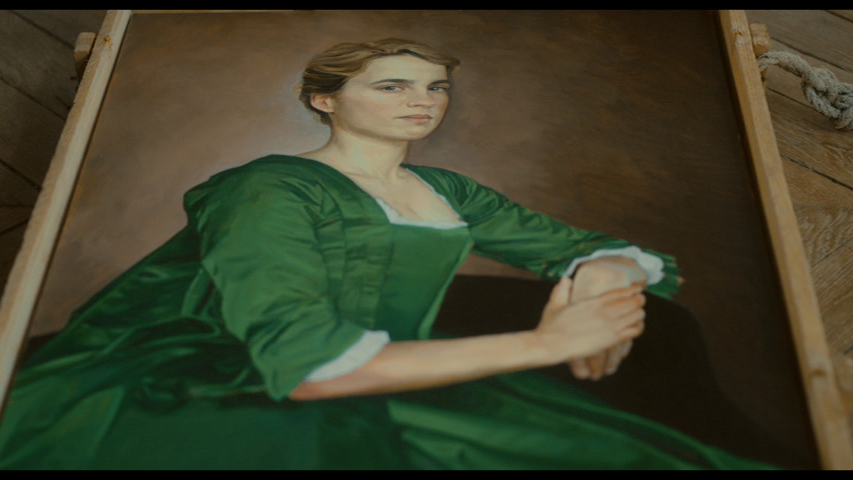

A man closes the crypt near the end of the film.
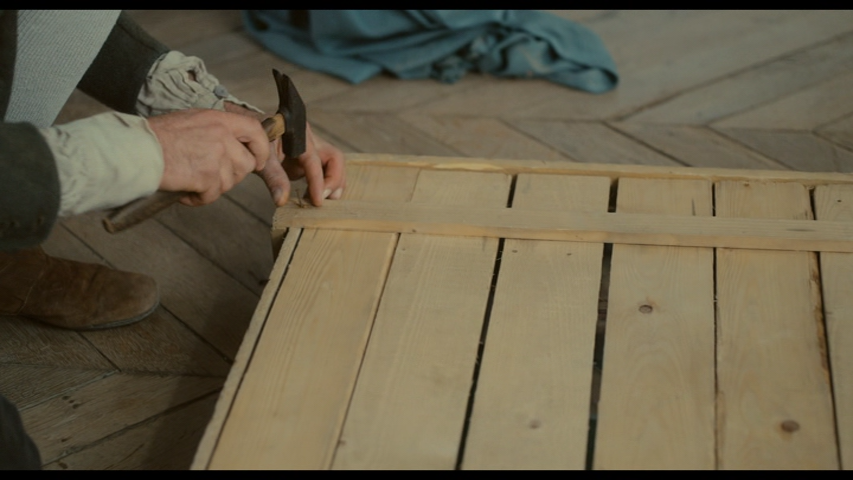
Marianne opens the crate and touches the two blank canvases and lets thee the fire in the fireplace dry them out.

The second portrait painted by Marianne.
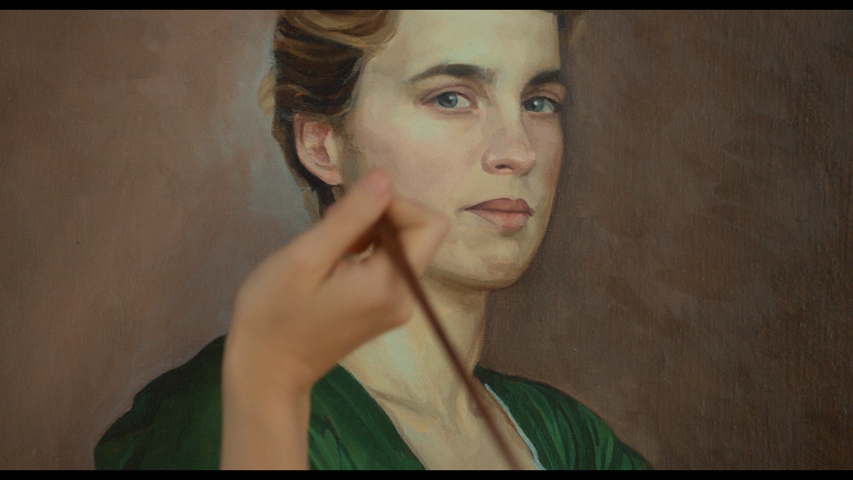
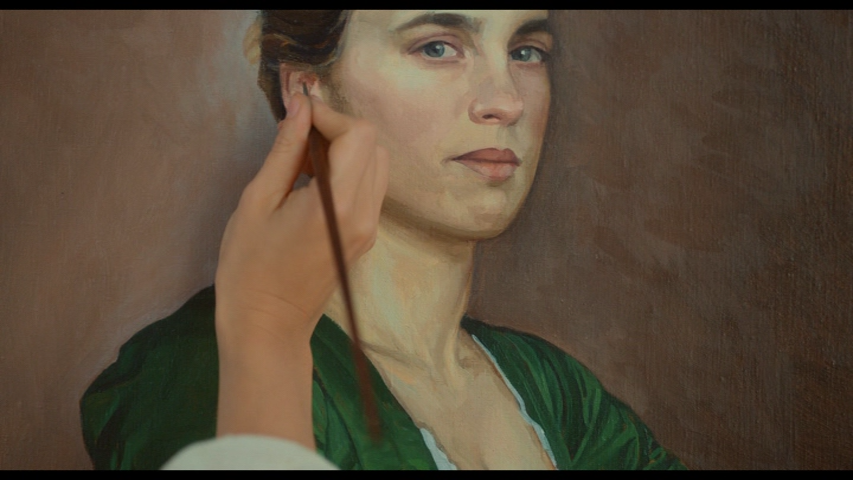
Finished, extreme close up.
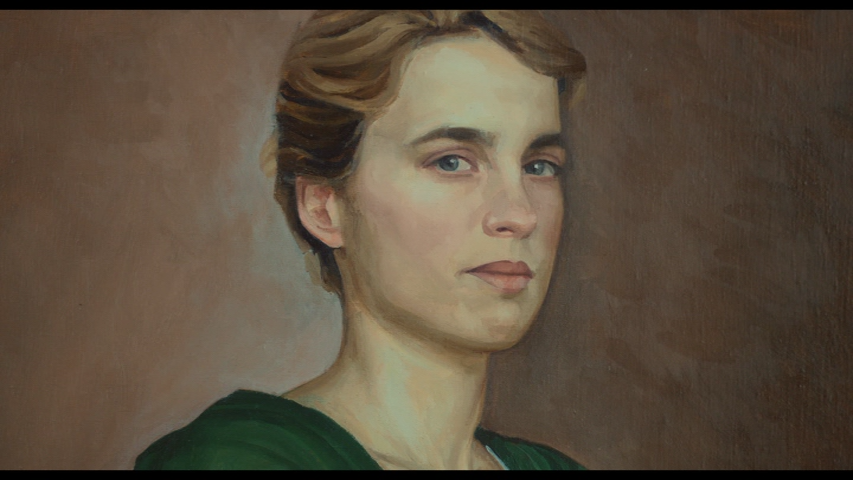
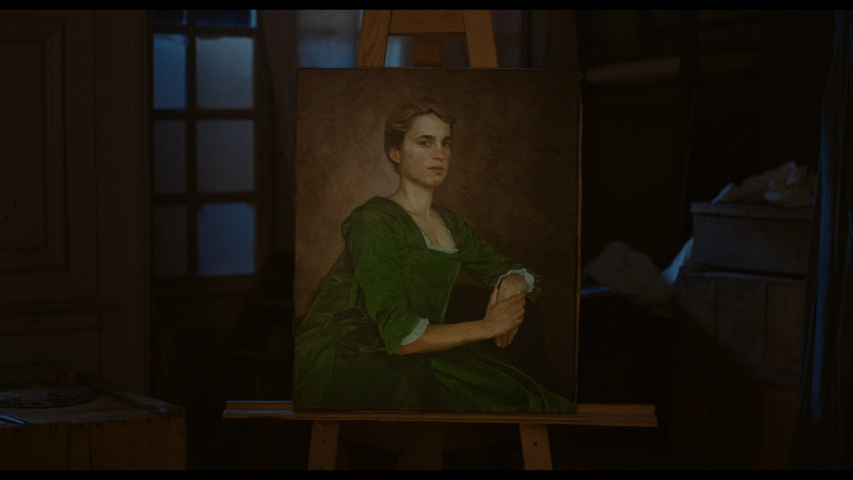
The second portrait near the end of the film.

Marianne's head is in our way very much the shot in which her head blocks our view of the canvas of the first portrait. See above.
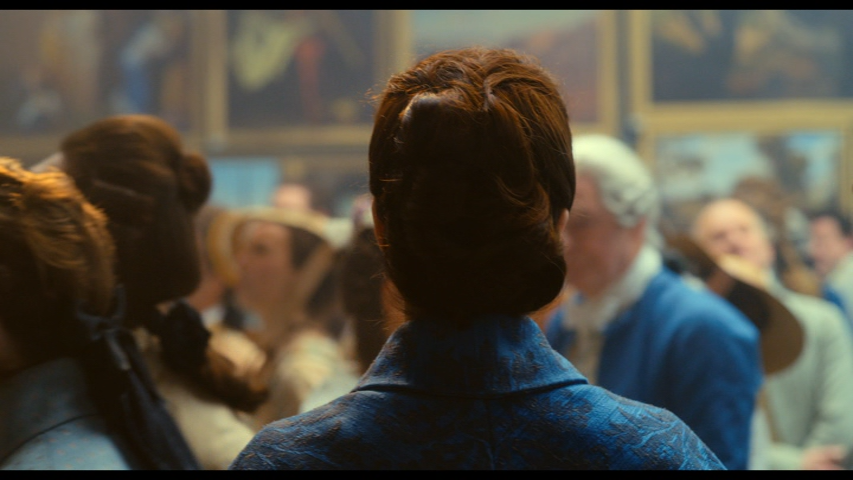
A man is in our way, with a woman at his side. Another chance for a delayed reveal.


The fourth portrait, mother and daughter. Who painted this portrait? Why is it apparently unsigned? Or is page 28 the signature; that is, Marianne's signature? (The same painter did all of the paintings for the film.)
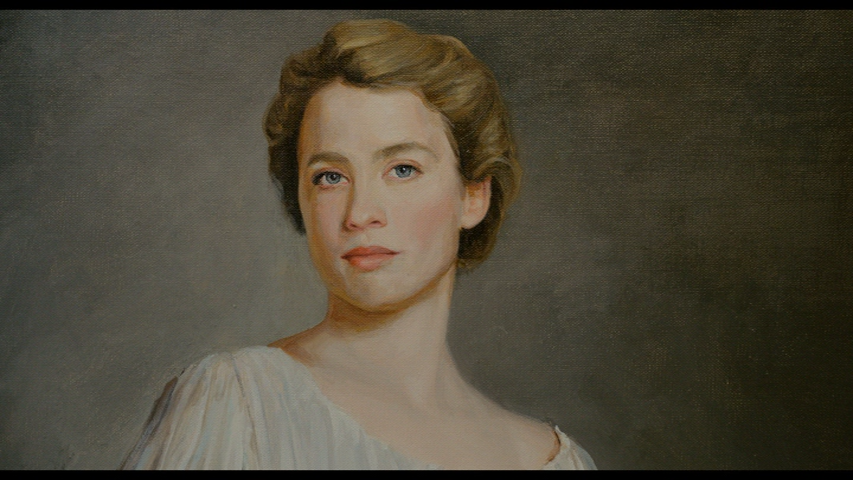
Marianne ends quite happy after noticing that Marianne has gingered page 28. (The daughter will grow up to have her portrait painted so she can married off to a man she has never met just as Marianne was by her mother).
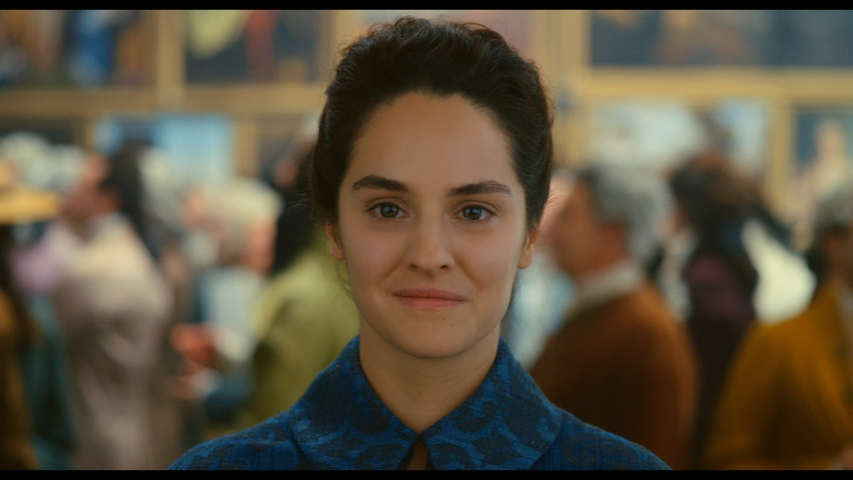
But Marianne turns out not be very happy. "I saw her one last line." The line begins when the camera is still on the protrait. Does "her" refer both to the portrait and the person?
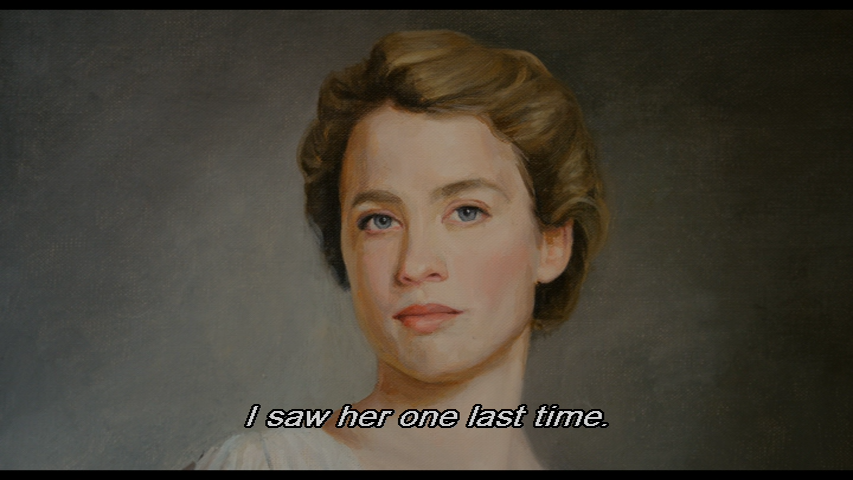
The film ends with symmetrical shots of the Marianne and Héloïse on opposites sides passing by people who are already seated and sitting down in what is perhaps an opera house.
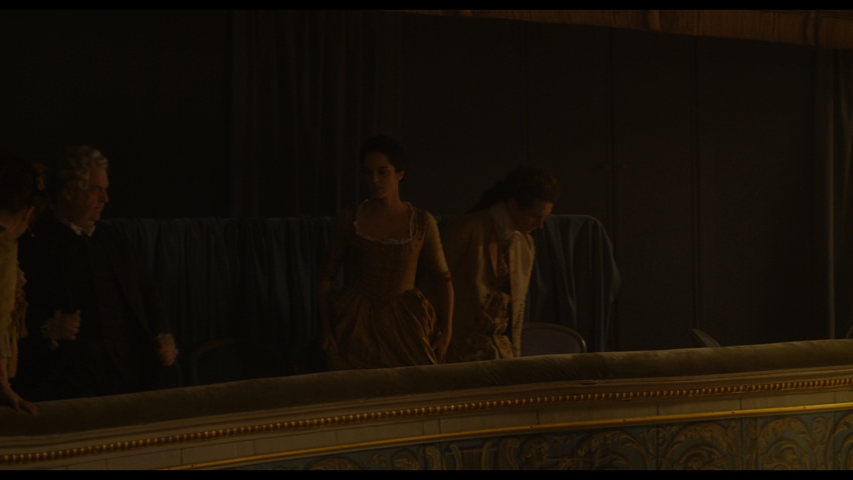
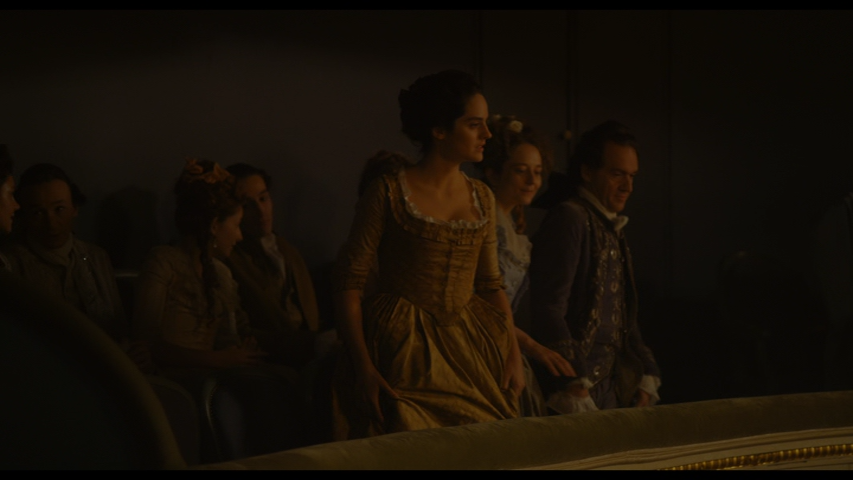
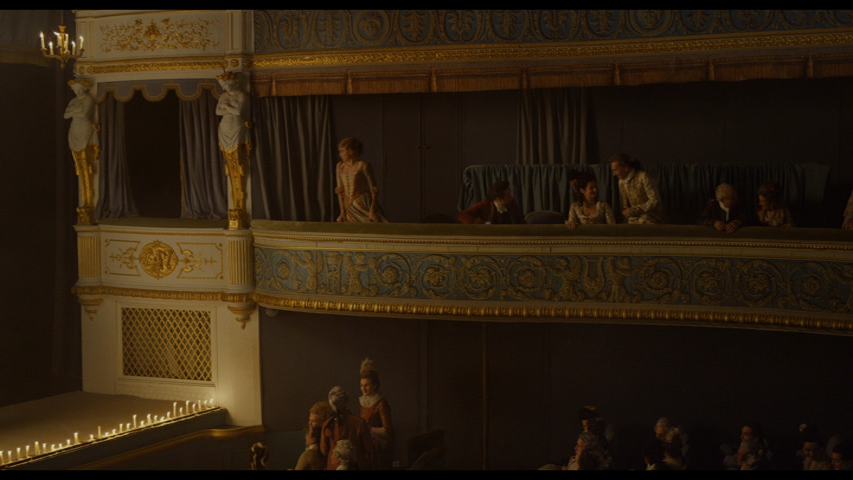
Marianne is sad, maybe bitter, that her gaze is not met.

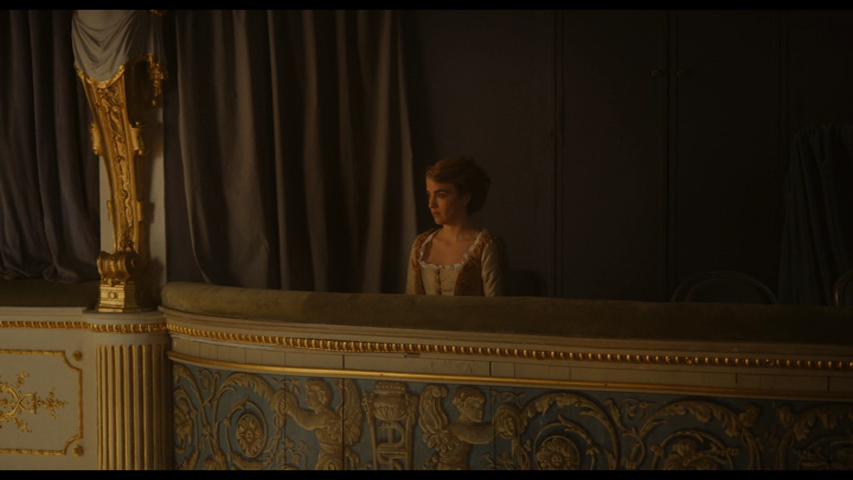
Are children not allowed? What about husbands?
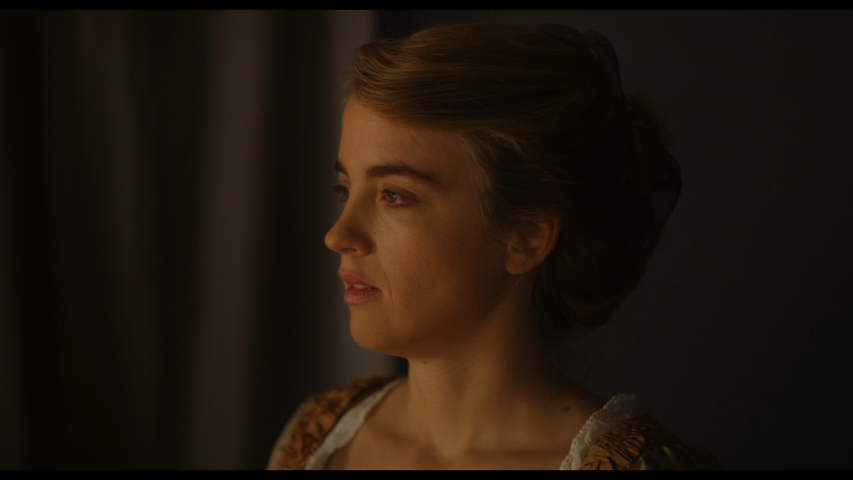
We Heloise for three minutes in the last shot of the film. Does the ending inject realism into the ideal or fantasy that you can remember each other at the same time? That you can always say good-bye again? Or maybe that's all you ever do? Or do? Say "Salut."
The third movement "Summer" in Vavaldi's Four Seasons (the piece Marianne tries to play on the piano) begins at the end of the last shot of Marianne and continues until the film ends, the same moment the music ends. Too much? Too commercial?
The music is extra-diegetic. Has Héloïse become a cinematic version of a portrait, contained by the film? Or is Héloïse unconsciously that Marianne, the director, and we are all staring at her? Is this a kind of portrait as masterpiece? Are we supposed to be impressed by the stamina of the actress?
What is Sophie the servant doing in the film about a couple? How did she get pregnant? The abortionist apparently also takes care of newborns.
Héloïse posing Sophie, turning the re-anactment of the abortion into a tableaux vivant, with Héloïse posed where the abortionist stood to perform the abortion so Marianne can paint it. Why is Marianne unable to watch the procedure until Heloise invites her or commands her to do so? The abortion includes an overhead shot of Sophie in bed with a baby next to playfully licking its lips. It's a long take, stationary camera. Are we to also pair Opheus and Eurydice with Héloïse and her dead sister? Are the newborn and foetus also comparable to the mythic couple? Or to Sophie and Héloïse's mother who blames herself for her daughter's suicide?
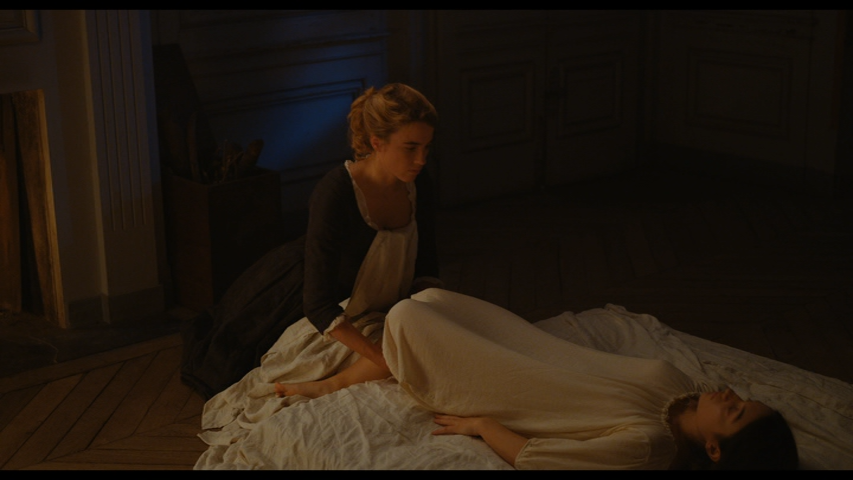
Two more of many face to face profile two shots.
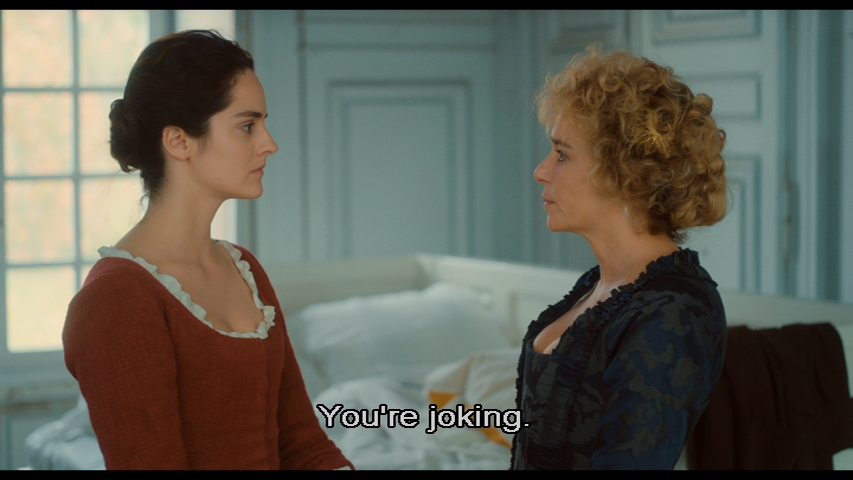
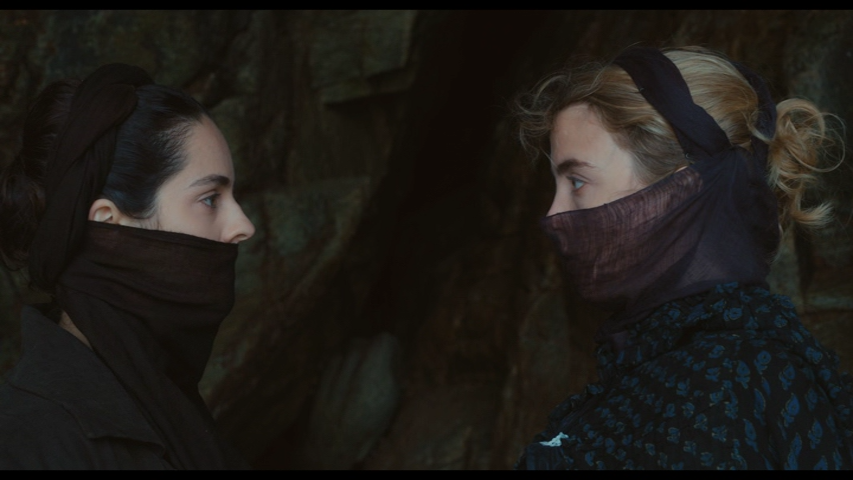
Holding hands on the beach after Marianne's dress burns.
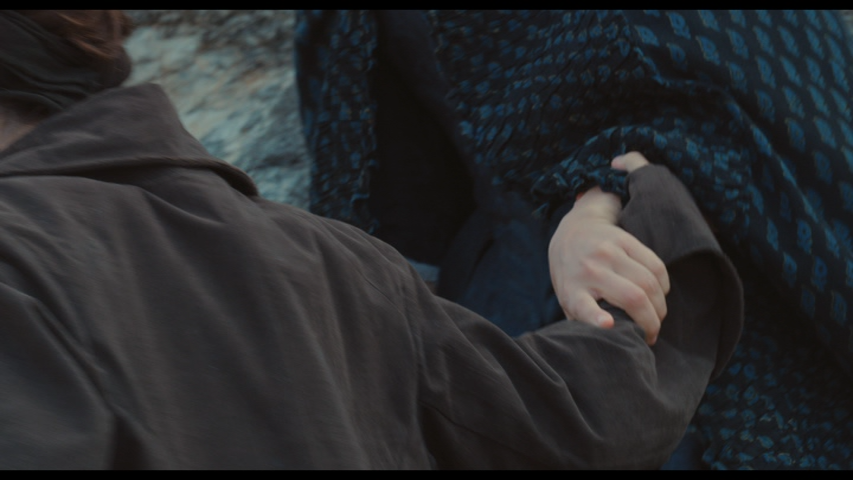
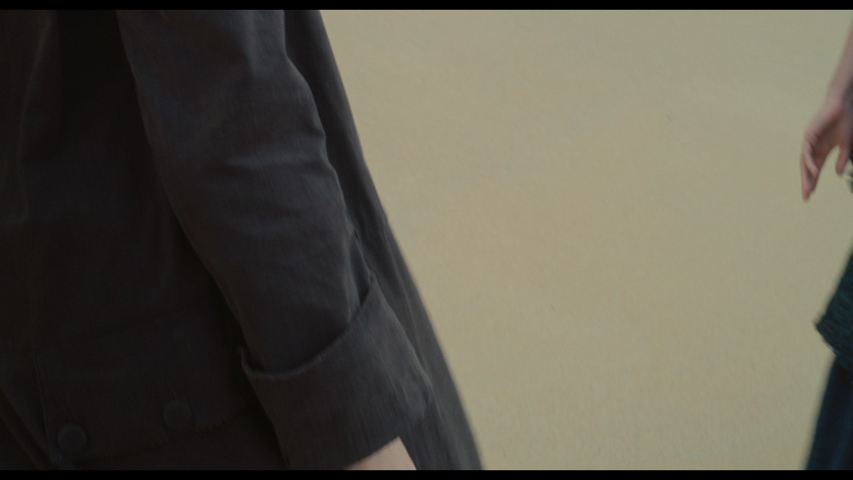
Furtive beach sketching of Héloïse's hands.
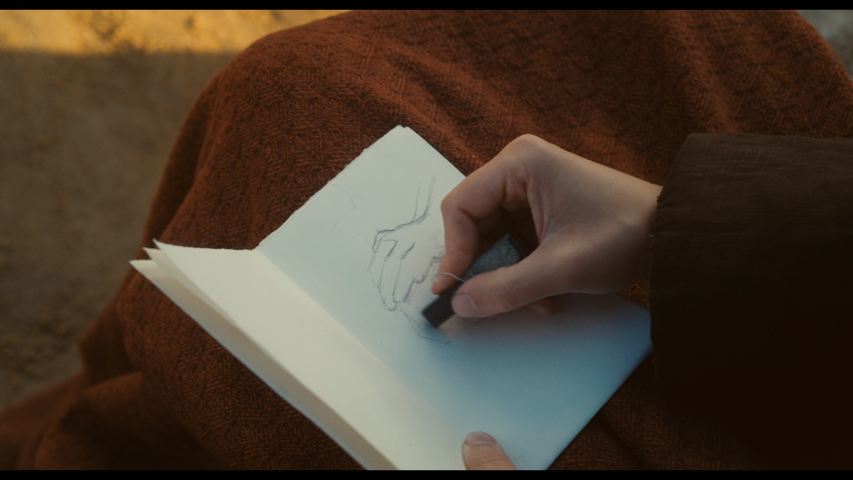
Underarm eroticism, nearly all of it shot in soft focus. The stimulant Héloïse offfers Marianne was applied by Héloïse under her left arm.
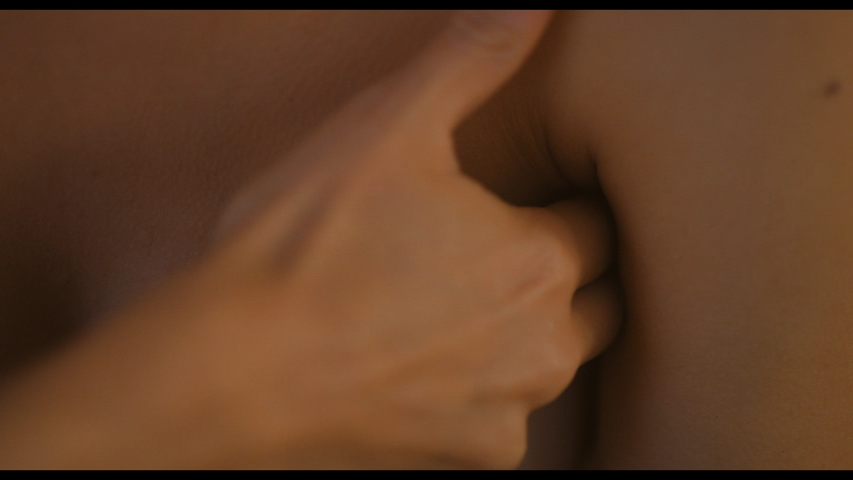
Can Heloise swim?
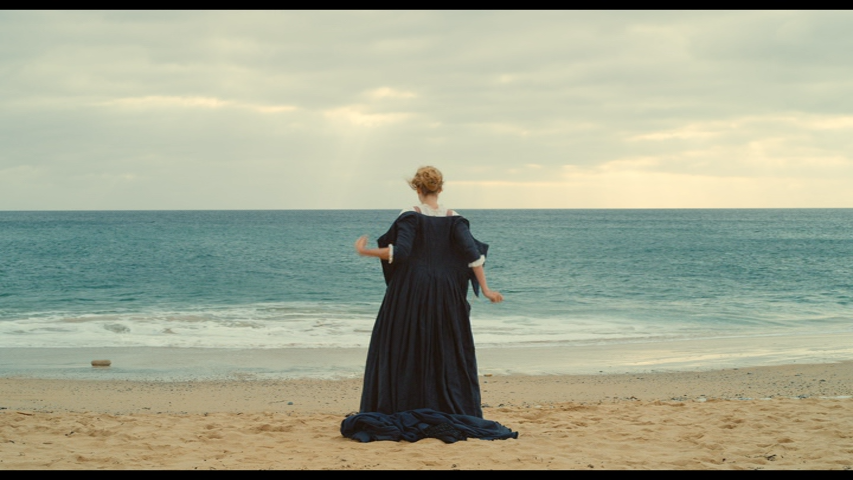
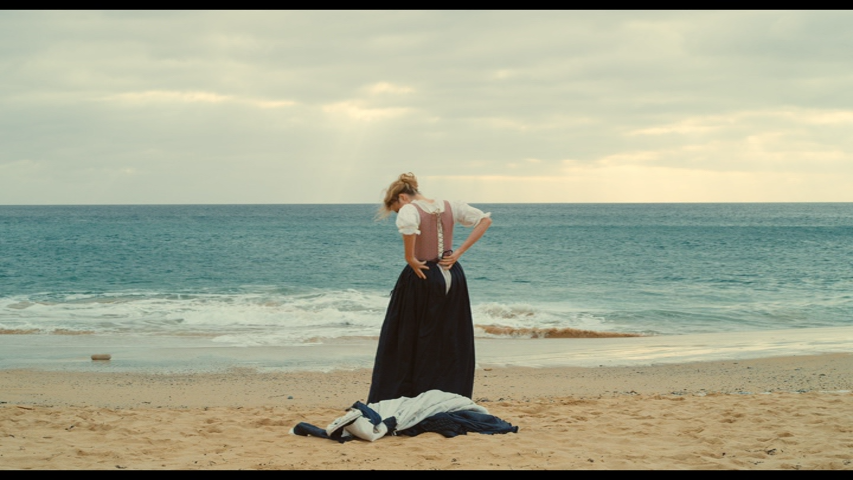
Carfeul viewrs (thank you, Rachel Mish) may notice that part of the the bottom dress has been damaged by the fire. This detail is difficult to spot as it you can see it for about one second.

Smokin! Ladies on fire.



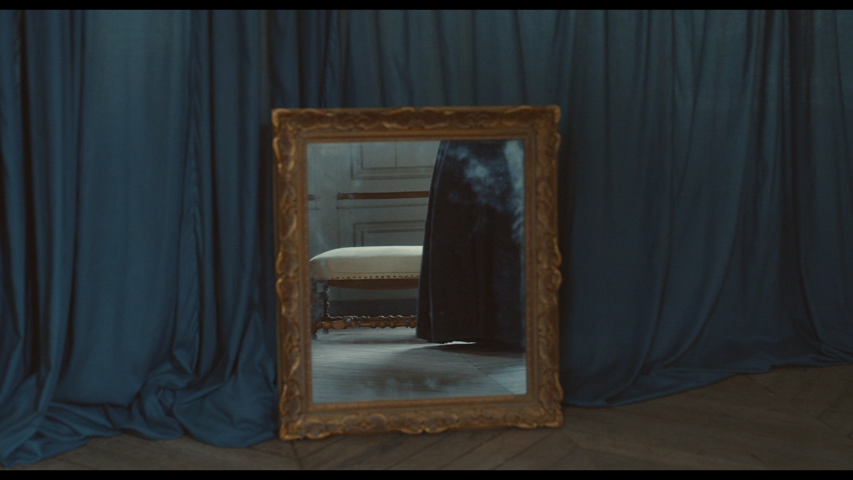

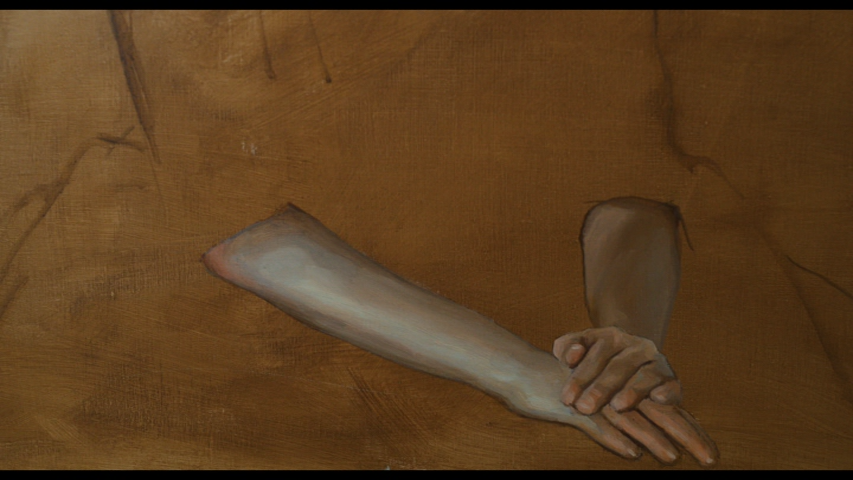

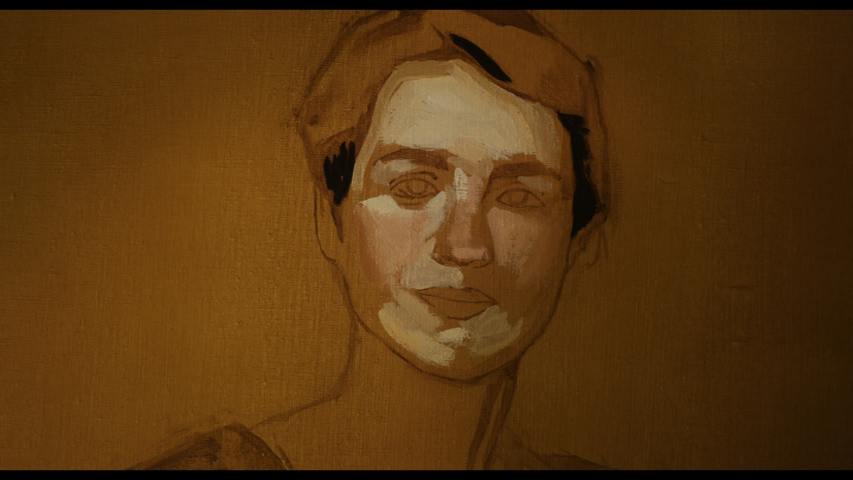
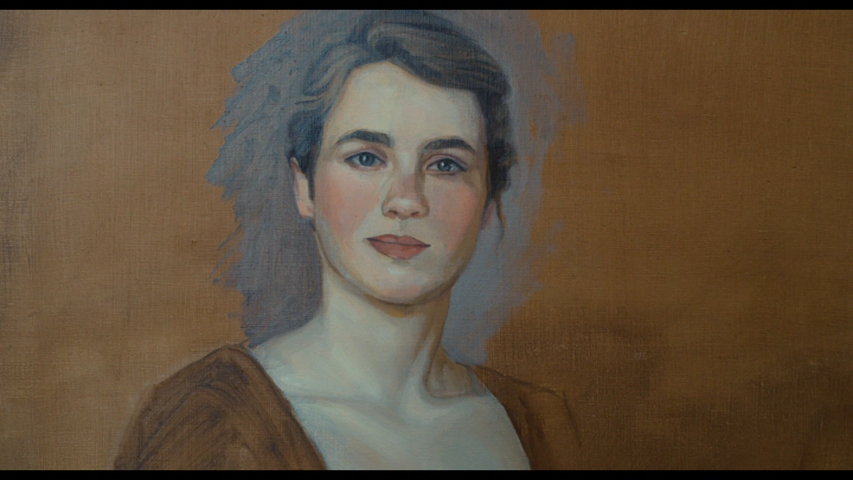
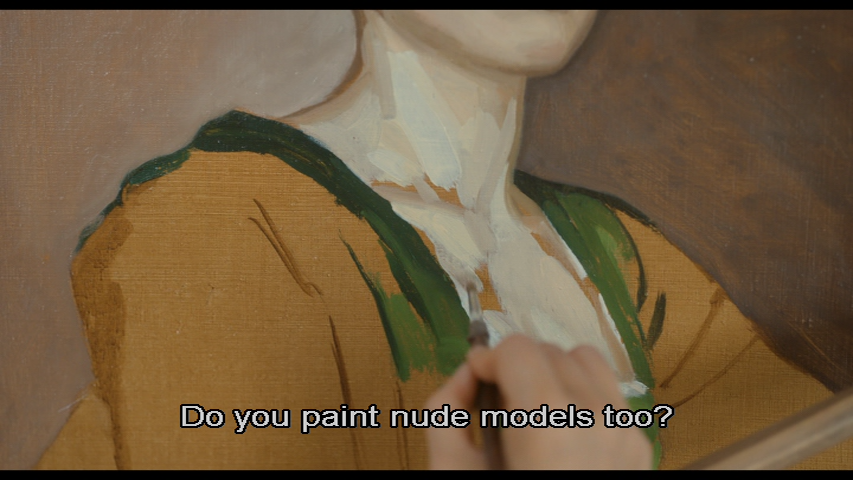

Marianne draws Heloise while Heloise is sleeping.

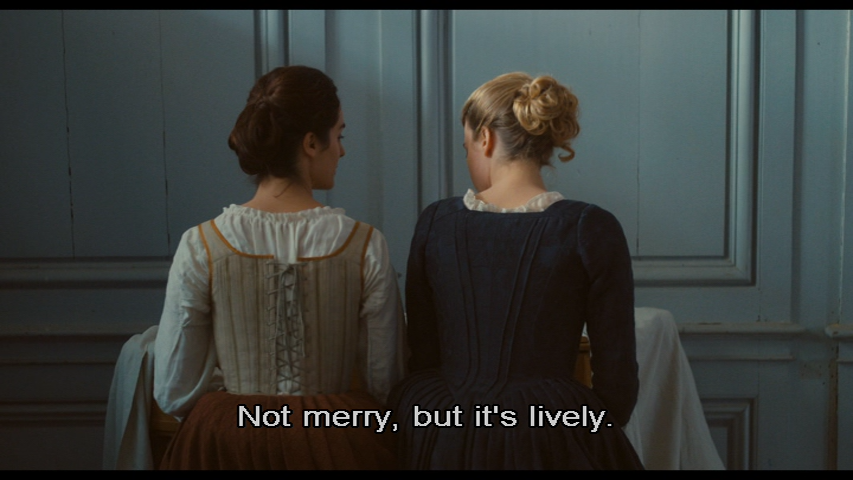
Mairanne's defaced sketches of Héloïse.



